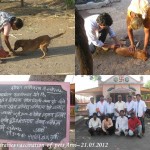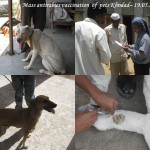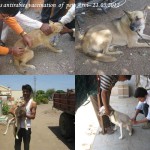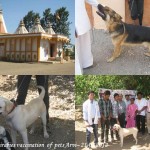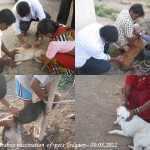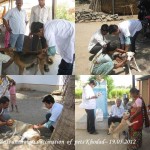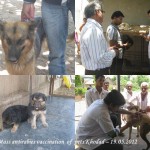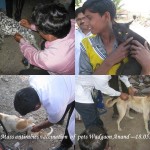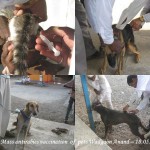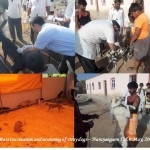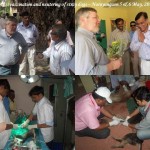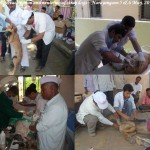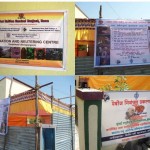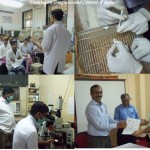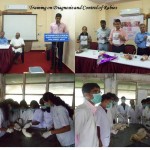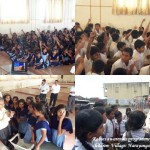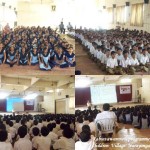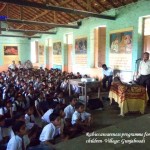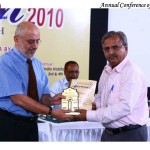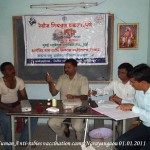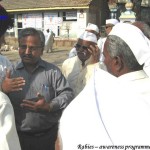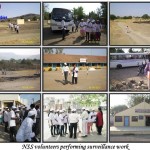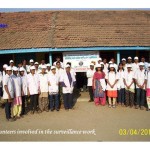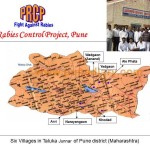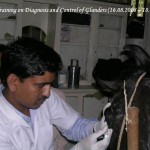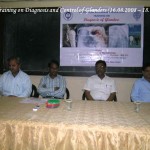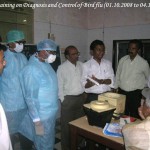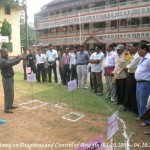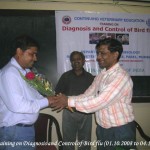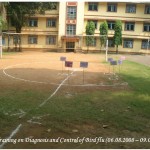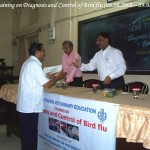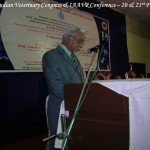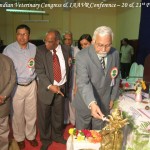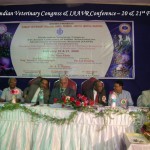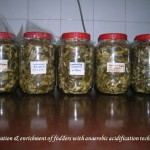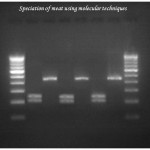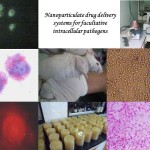UG Syllabus
Undergraduate Syllabus and Lecture Schedules of Veterinary Microbiology Course Structure
| Sr. No. | Course No. | Title | Credits | Semester |
| 1 | VMC 211 | General Veterinary Microbiology | 1+1=2 | III |
| 2 | VMC 221 | Veterinary Immunology & Serology | 1+1=2 | IV |
| 3 | VMC 311 | Systematic Veterinary Bacteriology & Mycology | 2+1=3 | V |
| 4 | VMC 321 | Systematic Veterinary Virology | 2+1=3 | VI |
| 5 | VLD 421* | Veterinary Clinical Biochemistry & Diagnosis | 0+1=1 | VIII |
| Course No. | VMC – 211 |
| Credits | 1+1=2 |
| Semester | III |
| Year | Second |
| S. N. | Topic outline |
| 1. | Introduction and History
|
| 2. | Classification and Nomenclature
|
| 3. | Morphology and Structure
|
| 4. | Structure contd:
|
| 5. | Growth and Nutrition of Bacteria
|
| 6. | Growth and Reproduction
|
| 7. | Infection
|
| 8. | Pathogenicity and Virulence
|
| 9. | Bacterial genetics
|
| 10. | Mycology:
|
| 11. | Growth and nutrition of fungi
|
| 12. | Virology:
|
| 13. |
|
| 14. | Replication of viruses
|
| 15. | Cell-virus interaction
|
| 16. | Viral genetics
|
| S.N. | Practical / Experiment |
| 1. | Equipments / Set-up of Microbiology laboratoryGeneral instructions for safety in Microbiology laboratory |
| 2. | Sterilization-Methods of sterilizationPhysical: Heat (dry / moist), Filtration: Different types of filters (Seitz / Membrane etc.); Radiation: UltravioletPreparation of materials for sterilization, Demonstration of working of Hot air oven, autoclave, instrument sterilizer, inspissator, Seitz and membrane filters etc. |
| 3. | Disinfection, antisepsis and asepsisDemonstration of method of estimation of phenol coefficient of chemical disinfectants |
| 4. | Bacterial Staining techniquesSimple staining: Methylene blue and Leishman’s stains |
| 5. | Differential staining – Gram’s staining |
| 6. | Differential staining – Acid-fast staining / Z. N. staining |
| 7. | Special staining – Metachromatic granules (Albert’s stain), capsule (Hiss or negative staining) and spore staining (Schaffer and Fulton’s staining) |
| 8. | Bacterial motilityStudy of bacterial motility by hanging drop preparation |
| 9. | Preparation of culture mediaLiquid media-Nutrient broth; Solid media-Basal- Nutrient AgarEnriched media- Blood Agar; Differential media- Mac Conkey’s agar,Indicator media- EMB Agar |
| 10. | Aerobic and anaerobic cultivation of bacteriaCulture Methods: Slant cultures, stab cultures, streak cultures, liquid culturesAnaerobic cultivation: Demonstration of anaerobic cultivation using McIntosh and Filde’s anaerobic jar, other methods of anaerobic cultivation viz. use of cooked meat medium etc. |
| 11. | Isolation of bacteria in pure culturesDifferent methods of obtaining pure cultures of bacteriaIsolation by streak plate method |
| 12. | Cultural characteristicsStudy of cultural characteristics of bacteria on different media (solid and liquid) |
| 13. | Morphological studies:Preparation of smear / film from bacterial culture, fixation, staining by Gram’s stain, morphological studies including shape, size, arrangement, staining reaction etc.Demonstration of slides of different organisms eg. Staphylococcus spp, Streptococcus spp., Corynebacterium spp., Bacillus anthracis, Pasteurella multocida, Escherichia coli, Salmonella spp., other Gram negative bacilli, Mycobacterium tuberculosis etc. |
| 14. | Biochemical characteristics: Demonstration ofCarbohydrate metabolism-Sugar fermentation tests, Methyl Red, Voges- Proskauer test; Protein breakdown- Indole, Nitrate, H2S production; Enzyme based tests- Catalase, oxidase, urease; Miscellaneous tests- Citrate test |
| 15 | Antibiotic sensitivity test– Disc diffusion technique |
| 16. | Slide culture technique and lactophenol cotton blue staining for fungus examination |
- Text Book of Microbiology by R. Ananthnarayan and C.K.J. Paniker
- Microbiology by Michael J. Pelczar, E.C.S. Chan and Noel R. Kreig
- Essentials of Veterinary Bacteriology and Mycology by G.R. Carter and Darla J. Wise
- Veterinary Virology by F.A. Murphy, E.P.J. Gibbs, M.C. Horzinek and M.J. Studdert
| Course No. | VMC- 221 |
| Credits | 1+1=2 |
| Semester | IV |
| Year | Second |
| S. N. | Topic outline |
| 1. | Historical development of Immunology.Introduction and scope of Veterinary Immunology |
| 2 | Immune system: Organs -central and peripheral lymphoid organs, Thymus, Bursa etc. Cells involved in immunity: Lymphocytes – classes, development of different types |
| 3 | Cells involved in immunity contd. T and B lymphocytes, macrophages, neutrophils etc.Major histocompatibility complex (MHC) – MHC classes, structure, role |
| 4 | Immunity: Definition, types of immunity- innate immunity, mechanisms of innate immunity (non-specific defense) |
| 5 | Immunity contd.: Acquired immunity – active and passive immunity |
| 6 | Immune response: Humoral and cellular immune response; Primary and secondary immune response |
| 7 | Antigen: Definition, properties and types of antigen, specificity of antigens, blood group antigens, Antigenic determinant / epitope, Factors influencing immunogenicity |
| 8 | Antibodies: Immunoglobulin structure, site and mechanism of antibody formation; theories of antibody production |
| 9 | Antibodies: Structure, properties and functions of different classes of immunoglobulinsHybridoma technique and monoclonal antibodies |
| 10 | Complement system: Complement components, Activation of complement by classical, alternate and mannose binding pathways. |
| 11 | Antigen-antibody reactions: General features of antigen-antibody reactions, antibody affinity, avidity, specificity; forces binding antigen and antibody |
| 12 | Principle and applications of precipitation and agglutination reactions; phagocytosis, opsonic index |
| 13 | Principle and applications of complement fixation, neutralization, cytolysis, toxin-antitoxin neutralization, immunofluorescence and enzyme immunoassays |
| 14 | Hypersensitivity: Definition, types of hypersensitivity- immediate and delayed hypersensitivity, mechanisms of different types of hypersensitivity reactions |
| 15 | Autoimmunity: Definition, mechaimsms, classification of autoimmune disorders with examples. Immunological tolerance. |
| 16 | Biologicals: Vaccines – inactivated, live and modern vaccines their advantages and disadvantages, adjuvants, quality control of vaccines |
| S.N. | Practical / Experiment |
| 1. | Preparation of antigenHeat killed / formalinized whole cell bacterinPreparation of sheep RBC suspension for raising haemolysin |
| 2 | Raising of antiseraRaising antiserum against particulate antigen e.g. haemolysin against sheep RBCsRaising antiserum against soluble antigen e.g. bovine serum albumin |
| 3 | Separation and concentration of immunoglobulins by ammonium sulfate precipitation method |
| 4 | Agglutination reactions:Plate / slide agglutination test e.g. RBPT for detection of Brucella antibodiesTube test e.g. standard tube agglutination test for detection of Brucella antibodies |
| 5 | Agglutination reactions contd.:Haemagglutination and haemagglutination-inhibition tests |
| 6 | Agglutination reactions contd.:Indirect / passive haemagglutination testLatex co-agglutination test |
| 7 | Precipitation reactions:Agar gel precipitation test |
| 8 | Precipitation reactions contd.:Radial immunodiffusion (RID)Counter immunoelectrophoresis (CIE)Rocket immunoelectrophoresis (RIE) |
| 9 | Complement fixation test:Titration of complement and haemolysin |
| 10 | Complement fixation test:Complement fixation test proper |
| 11 | Immunoperoxidase test |
| 12 | Immunofluorescence test |
| 13 | Enzyme linked immunosorbent assay (ELISA)Direct ELISA |
| 14 | ELISA: indirect, sandwich, dot-ELISA |
| 15 | Detection of cell mediated immunity:Demonstration of tuberculin testing |
| 16 | Visit to veterinary biologicals |
- Veterinary Immunology: An Introduction by Ian R. Tizard
- Text book of Microbiology by R. Anantnarayan and C.K.J. Paniker
| Course No. | VMC-311 |
| Credits | 2+1=3 |
| Semester | V |
| Year | Third |
| S. N. | Topic outline |
| Study of following pathogenic bacteria and fungi in relation to their, morphology, staining characters, isolation, growth requirements and cultural characters, biochemical properties, antigenic characters and toxins, pathogenicity, diagnosis and immunity | |
| 1. | Genus: Staphylococcus, Extracellular metabolites of Staphylococci |
| 2 |
|
| 3 | Genus: Streptococcus
|
| 4 | Genus: Streptococcus contd.
|
| 5 | Genus: Bacillus
|
| 6 | Genus: Clostridum
|
| 7 |
|
| 8 | Genus: Mycobacterium
|
| 9 | Genus: Mycobacterium contd.
|
| 10 | Family: Enterobacteriaceae- General features and classificationGenus: Escherichia
|
| 11 | Genus: Salmonella
|
| 12 | Genus: Yersinia
|
| 13 | Genus: Klebsiella
|
| 14 | Genus: Campylobacter
|
| 15 | Genus: Brucella
|
| 16 | Genus: Pasteurella
|
| 17 | Genus: Pseudomonas
|
| 18 | Genus: Moraxella
|
| 19 | Genus: Actinobacillus
|
| 20 | Genus: Listeria
|
| 21 | Genus: Arcanobacterium
|
| 22 | Genus: Nocardia
|
| 23 | SpirochaetesGenus: Leptospira
|
| 24 | Genus: Mycoplasma
|
| 25 | Rickettsia
|
| 26 | Chlamydia
|
| 27 | Dermatophytes
|
| 28 | Genus: Aspergillus
|
| 29 |
|
| 30 |
|
| 31 |
|
| 32 |
|
| S.N. | Practical / Experiment |
| Laboratory identification of agents of….. | |
| 1. | Mastitis:
|
| 2 | Mastitis contd.:
|
| 3 | Haemorrhagic septicaemia:
|
| 4 | Enteric infections:
|
| 5 | Enteric infections contd:
|
| 6 | Brucellosis:
|
| 7 | Tuberculosis:
|
| 8 | Johne’s disease:
|
| 9 | Clostridial infections: Black quarter
|
| 10 | Clostridial infections: Enterotoxaemia
|
| 11 | Wooden tongue / lumpy jaw:
|
| 12 | Anthrax:
|
| 13 | Glanders:Mallein testing |
| 14 | Aspergillosis:
|
| 15 | Dermatophytosis:
|
| 16 | Yeasts:
|
- Essentials of Veterinary Bacteriology & Mycology by G.R. Carter and D.J. Wise
- Text Book of Veterinary Microbiology by Prof. S.N. Sharma & S.C. Adlakha
- Veterinary Bacteriology and Virology byI.A. Merchant & R. A. Packer
| Course No. | VMC – 321 |
| Credits | 2+1=3 |
| Semester | VI |
| Year | Third |
| S. N. | Topic outline |
| 1 | Brief History of virology, classification and important characteristics of various families of DNA. |
| Study of following viruses causing diseases in livestock and poultry with reference to classification, morphology, physico-chemical properties, cultivation, antigenic characters, pathogenicity, laboratory diagnosis and immunity | |
| DNA VIRUSES | |
| 2 | Poxviridae : Cowpox, buffalo pox, fowl pox |
| 3 | Poxviridae contd.: Sheep pox, goat pox, lumpy skin disease, orf |
| 4 | Asfaviridae : African swine fever |
| 5 | Herpesviridae: Pseudorabies, Malignant catarrhal fever, Infectious bovine rhinotracheitis and equine abortions |
| 6 | Herpesviridae contd.: Marek’s disease and infectious laryngotracheitis |
| 7 | Adenoviridae: Infectious canine hepatitis |
| 8 | Adenoviridae contd.: Egg drop syndrome, Inclusion body hepatitis – Hydropericardium syndrome |
| 9 | Papillomaviridae: Papillomatosis |
| 10 | Parvoviridae: Canine parvovirus |
| 11 | Circoviridae: Chicken infectious anemia |
| RNA VIRUSES | |
| 12 | Orthomyxoviridae: swine influenza, equine influenza |
| 13 | Orthomyxoviridae contd.: Avian Influenza |
| 14 | Paramyxoviridae: Rinderpest, PPR |
| 15 | Paramyxoviridae contd.: Canine distemper |
| 16 | Paramyxoviridae contd.: Ranikhet disease |
| 17 | Flaviviridae: classical swine fever, bovine viral diarrhoea |
| 18 | Picornaviridae: Duck viral hepatitis |
| 19 | Picornaviridae contd.: Foot and Mouth disease |
| 20 | Rhabdoviridae: ephemeral fever, vesicular stomatitis |
| 21 | Rhabdoviridae contd.: Rabies |
| 22 | Coronaviridae: Avian infectious Bronchitis, Transmissible gastroenteritis |
| 23 | Togaviridae: Equine encephalitis (WEE, EEE and VEE) |
| 24 | Arteriviridae: Equine viral arteritisCaliciviridae: Vescicular exanthema |
| 25 | Retroviridae: Avian leucosis |
| 26 | Lentiviruses: Equine infectious anemia |
| 27 | Lentiviruses contd.: Maedi, visna, sheep pulmonary adenomatosis |
| 28 | Reoviridae: African horse sickness |
| 29 | Reoviridae contd.: Blue tongue, Calf rotavirus |
| 30 | Birnaviridae: Infectious bursal disease |
| 31 | Prions: BSE, Scrapie |
| 32 | Emerging animal and poultry viruses – equine morbillivirus, porcine reproductive and respiratory syndrome virus, Nipah, Hanta Chandipura |
| S. N. | Practical |
| 1. | Preparation of glassware and equipments for virus work |
| 2. | Preparation of media, solutions, buffers and their sterilization |
| 3. | Demonstration of primary cell culture Preparation and subculturing the cell line |
| 4. | Chick embryo inoculation and harvesting of virusAllantoic and Chorio-allantoic membrane routes |
| 5. | Chick embryo inoculation and harvesting of virusAmniotic and yolk sac routes |
| 6. | Animal inoculation for cultivation of viruses |
| 7. | Infection of cell cultures with virus and study of cytopathic effects – Demonstration |
| 8. | Study of viral inclusions: Detection of Negri bodies in brain brain impression smears stained by Seller’s stain |
| 9. | Collection, preservation and transport of clinical specimen for virological investigations |
| 10. | Processing of material for virus isolation |
| Diagnostic procedures for following viral diseases including collection of specimens, preservation, processing and application of specific tests | |
| 11. | Peste des petits ruminants (PPR): ELISA / AGID |
| 12. | Foot and mouth disease (FMD): CFT / ELISA |
| 13. | Ranikhet disease (RD): Chicken embryo inoculation, HA & HI |
| 14. | Bluetongue: AGID / ELISA |
| 15. | Avian infectious bronchitis and infectious bursal disease: Chicken embryo inoculation / AGID |
| 16. | Canine Parovirus: Haemagglutination testInfectious bovine rhinotrachitis (IBR): dot ELISA |
- Veterinary Virology by F.A. Murphy, E.P.J. Gibbs, M.C. Horzinek and M.J. Studdert
- Veterinary Virology by S. N. Sharma and S.C. Adlakha
- Veterinary Virology by S. B. Mohanty and S.K. Datta
| Course No. | VLD – 421 |
| Credits | 0+1=1 |
| Semester | VIII |
| Year | Fourth |
| S. N. | Practical / Experiment |
| 1 to 16 |
|
PG Syllabus
M.V.Sc. Programme in Veterinary Microbiology as per ICAR guidelines Minimum Credit Requirements:
Major / Minor / Supporting Subjects:
COURSE STRUCTURE
Semester-wise distribution of courses
Semester-wise distribution of credits
Bacteriology I
THEORY
PRACTICAL
Suggested Readings: S. Peter Borriello, Patrick R. Murray and Guido Funke. Topley andWilson’s Microbiology and Microbial Infections, Bacteriology Volumes I & II. Hodder Arnold Glen Sonder J & Karen W Post 2005. Veterinary Microbiology: Bacterial and Fungal Agents of Animal Diseases. ColdSpringHarbor Lab. Press. Prescot LM, Harley JP & Klen DA. 2005. Microbiology. Wm. C. Brown Publ. Tortora GJ, Funke BR & Case CL. 2004. Microbiology: An Introduction. Benjamin/Cummins Publ. C.L. Gyles, J. .F Prescott, J.G. Songer, C.O. Thoen. Pathogenesis of Bacterial Infections in Animals. 2004 Wiley Bacteriology II
THEORY
PRACTICAL
Suggested Readings: S. Peter Borriello, Patrick R. Murray and Guido Funke. Topley andWilson’s Microbiology and Microbial Infections, Bacteriology Volumes I & II. Hodder Arnold Glen Sonder J & Karen W Post 2005. Veterinary Microbiology: Bacterial and Fungal Agents of Animal Diseases. ColdSpringHarbor Lab. Press. Prescot LM, Harley JP & Klen DA. 2005. Microbiology. Wm. C. Brown Publ. Tortora GJ, Funke BR & Case CL. 2004. Microbiology: An Introduction. Benjamin/Cummins Publ. C.L. Gyles, J. .F Prescott, J.G. Songer, C.O. Thoen. Pathogenesis of Bacterial Infections in Animals. 2004 Wiley Veterinary Mycology
THEORY
PRACTICAL
Suggested Readings Glen Sonder J & Karen W Post 2005. Veterinary Microbiology: Bacterial and Fungal Agents of Animal Diseases.ColdSpringHarbor Lab. Press. Essentials of Veterinary Bacteriology and Mycology by Carter General Virology
THEORY
PRACTICAL
Suggested Readings: Murphy FA, Gibbs EPJ, Holzmek MK and Studdert MJ. 1999 Veterinary Virology. 3rd Ed. Academic Press. Achesons NH. 2006. Fundamentals of Molecular Virology. Wiley.Carter J and Saunders V. 2007 Virology: Principles and Applications. 1st Ed. Wiley. Knipe Dm, Howley PM, GriffithDE. 2006 Field Virology . 5th Ed. Vol. I and II. Lippoincott, Williams and Wilkins Mahy BWJ and Kangaroo HO, 1996. Virological Methods Manual. Academic Press Systematic Animal Virology
THEORY
PRACTICAL
Suggested readings: Murphy FA, Gibbs EPJ, Holzmek MK and Studdert MJ. 1999 Veterinary Virology. 3rd Ed. Academic Press. Achesons NH. 2006. Fundamentals of Molecular Virology. Wiley. Carter J and Saunders V. 2007 Virology: Principles and Applications. 1st Ed. Wiley. Knipe Dm, Howley PM, GriffithDE. 2006 Field Virology . 5th Ed. Vol. I and II. Lippoincott, Williams and Wilkins Mahy BWJ and Kangaroo HO, 1996. Virological Methods Manual. Academic Press Principles of Immunology
THEORY
PRACTICAL
Suggested Readings:1. Kindt TJ, Goldsby RA & Osborne BA. 2007. Kuby Immunology. 6th Ed. WH Freeman.2. Male D, Brostoff J, RothDB & RoittsI.2007. Immunology. 7th Ed. Mosby- Elsevier.3. Tizard IR. 2004. Veterinary Immunology: An Introduction. 7th Ed. Saunders/Elsevier. Vaccinology
Suggested Readings: 1. Dodds WJ & Schulz R. (Eds). 1999. Veterinary Vaccines and Diagnostics. Vol. 41 (Advances in Veterinary Medicine) 1st Ed. Academic Press.2 Levine MM, Kaper JB, Rappuoli R, Liu MA & Good MF. 2004. New Generation Vaccines. 3rd Ed. Marcel-Dekker.3. Pastoret PP, Blancou J, Vannier C & Verschueren C. 1997. Veterinary Vaccinology. Elsevier. Diagnosis of Infectious Diseases
THEORY
PRACTICALS
Suggested Readings: 1. Detrick B & Hamilton RG. (Eds). 2006. Manual of Molecular and ClinicalLaboratory Immunology. 7th Ed. American Society for Microbiology. 2. Rose NR, Friedman H & Fahey JL. (Eds). 1986. Manual of ClinicalLaboratory Immunology. American Society for Microbiology. 3. DM. 1986. Handbook of Experimental Immunology. Vol. IV. Blackwell. Techniques in Microbiology and Immunology
Suggested Readings 1. Coligan JE, Kruisbeek AM, Margulies DH, Shevach EM & Strober W. 2003. Current Protocols in Immunology. 3rd Ed. John Wiley & Sons. 2. Detrick B & Hamilton RG. (Eds). 2006. Manual of Molecular and Clinical Laboratory Immunology. 7th Ed. American Society for Microbiology. 3. Hay FC & Westwood OMR. 2002. Practical Immunology. 4th Ed. Blackwell. 4. Mahy BWJ & Kangaro HO. 1996. Virology Methods Manual. Academic Press. 5. Quinn PJ, Carter ME, Markey B & Carter GR. 1994. Clinical Veterinary Microbiology. Wolfe Publ. Ph.D. Programme in Veterinary Microbiology as per ICAR guidelines Minimum Credit Requirements:
Major / Minor / Supporting Subjects:
COURSE STRUCTURE
Semester-wise distribution of credits:
TEACHING SCHEDULESAdvances in Bacteriology
Advances in Mycology
Bacterial Genetics
Microbial Toxins
THEORY
Molecular Determinants of Bacterial Pathogenesis
THEORY
Advances in Virology
Molecular & Genetic Aspects of Viral Pathogenesis
Structure Function Relationship of DNA & RNA Viruses
Oncogenic Viruses
THEORY
Slow Viral Infections & Prions
Molecular Immunology
Advances in Cellular Immunology
Cytokines & Immunomodulators
Advances in Vaccinology
Advances in Immunodiagnostics
Modern Immunotechnology
THEORY
Current Topics in Infection & Immunity
Veterinary Microbial Biotechnology
Special Problem
| S.N. | Subject | Credit Requirement |
| 1 | Major | 28 |
| 2 | Minor + Supporting | 11 |
| 3 | Seminar | 01 |
| 4 | Research | 20 |
| TOTAL | 60 |
| Major Subject | Veterinary Microbiology |
| Minor + Supporting Subject | Animal BiotechnologyVeterinary Epidemiology & Preventive MedicineVeterinary PathologyVeterinary Public HealthVeterinary Biochemistry |
| S. N. | Course No. | Title | Credits | Semester |
| 1 | VMC 601 | Bacteriology-I | 3+1=4 | I |
| 2 | VMC 602 | Bacteriology-II | 3+1=4 | II |
| 3 | VMC 603 | Veterinary Mycology | 1+1=2 | II |
| 4 | VMC 604 | General Virology | 2+1=3 | I |
| 5 | VMC 605 | Systematic Animal Virology | 3+1=4 | II |
| 6 | VMC 606 | Principles of Immunology | 2+1=3 | I |
| 7 | VMC 607 | Vaccinology | 2+0=2 | III |
| 8 | VMC 608 | Diagnostics of Infectious Diseases | 1+2=3 | III |
| 9 | VMC 609 | Techniques in Microbiology &Immunology | 0+3=3 | I |
| 10 | VMC 691 | Master’s Seminar | 0+1=1 | III |
| 11 | VMC 699 | Master’s Research | 20 | III & IV |
| S. N. | Course No. | Title | Credits |
| SEMESTER I | |||
| 1 | VMC 601 | Bacteriology-I | 3+1=4 |
| 2 | VMC 604 | General Virology | 2+1=3 |
| 3 | VMC 606 | Principles of Immunology | 2+1=3 |
| 4 | VMC 609 | Techniques in Microbiology &Immunology | 0+3=3 |
| SEMESTER II | |||
| 5 | VMC 602 | Bacteriology-II | 3+1=4 |
| 6 | VMC 603 | Veterinary Mycology | 1+1=2 |
| 7 | VMC 605 | Systematic Animal Virology | 3+1=4 |
| SEMESTER III | |||
| 8 | VMC 607 | Vaccinology | 2+0=2 |
| 9 | VMC 608 | Diagnostics of Infectious Diseases | 1+2=3 |
| 10 | VMC 691 | Master’s Seminar | 0+1=1 |
| SEMESTER IV | |||
| 11 | VMC 699 | Master’s Research | 20 |
| S. N. | Semester | Major | Minor + Supporting | Total | |
| Course work | Research | ||||
| 1 | I | 13 | – | 3 | 16 |
| 2 | II | 10 | – | 6 | 16 |
| 3 | III | 6 | 5 | 2 | 13 |
| 4 | IV | – | 15 | – | 15 |
| TOTAL | 29 | 20 | 11 | 60 | |
| Course No. | VMC- 601 | Title | Bacteriology I |
| Credits | 3+1 = 4 | Semester | I |
| Lecture Nos. | Topic |
| UNIT I | |
| 1 | Historical introduction |
| 2-3 | Cellular organization, genetic & chemical characteristics of eukaryotic and prokaryotic cells |
| 4-5 | Classification and nomenclature of bacteria; Genetic characterization and Numerical Taxonomy |
| 6 | Identification of bacteria; classic methods, molecular techniques |
| 7-9 | Structure, composition and functions of bacterial cell and its different components viz. cell wall, cytoplasmic membrane, cytoplasm, ribosomes, nuclear material, inclusions appendages like capsule, flagella, fimbriae, endospores, plasmids etc. |
| 10 | Physiology and Nutrition; Nutritional types, nutritional and physiological requirements |
| 11-13 | Bacterial metabolism: Bioenergetics, generation of energy and transfer, oxidation-reduction system, membrane transport, electron transport system, aerobic and anaerobic respiration, carbohydrate, protein, lipid metabolism, biosynthesis of macromolecules |
| 14-15 | Bacterial growth; measurement of bacterial growth, bacterial growth curve |
| UNIT II | |
| 16-18 | Determinants of Pathogenicity and its molecular basis: Invasiveness, invasins, toxigenesis, exotoxins and endotoxins and mechanism of their action, adherence, colonization, evasion of host defenses |
| 19 | Bacteriophages: temperate and virulent phages; lysogeny and lysogenic conversion |
| 20-22 | Bacterial genetics: Bacterial variation; phenotypic and genotypic variations, mutations and mutagenesis, gene transfer mechanisms – conjugation, transformation, transduction, Plasmids, transposons, cosmids, insertion sequences, transferable drug resistance, Recombinant DNA technology |
| 23 | Antimicrobial agents: Classes of antimicrobials and mechanism of action. |
| UNIT III | |
| Systematic study of following bacteria with respect to their taxonomic position, distribution, morphology and staining characters, growth requirements and characteristics, antigenic structure, virulence factors, pathogenicity, diagnosis, immunity and control | |
| 24 | Family: Enterobacteriaceae Classification and General features |
| 25-26 | Genus Escherichia, E. coli, |
| 27 | Genus Shigella, S. dysenteriae, S. flexneri, S. boydii, S. sonnei |
| 28-30 | Genus Salmonella, S. enterica, S. enterica subsp. enterica, Serotypes of subsp. enterica Typhi, Paratyphi A, Typhimurium, Choleraesuis, Gallinarum, Pullorum, Dublin, Abortusequi, Abortusovis |
| 31 | Genus Proteus, P. mirabilis, P. vulgaris |
| Genus Morganella, M. morganii, Genus Providencia | |
| 32 | Genus Yersinia, Y. pestis, Y. pseudotuberculosis, Y. enterocolitica |
| 33 | Genus Klebsiella, K. pneumoniae, K. pneumoniae subsp. pneumoniae, K. oxytoca |
| 34 | Genus Enterobacter, E. aerogenes, E. cloacae |
| Genus Citrobacter, C. freundii, C. Rodentium | |
| Genus Edwardsiella, E. tarda, E. ictaluri | |
| 35 | Genus Vibrio, V. cholerae, V. parahaemolyticus, V. metschnikovii |
| 36 | Genus Aeromonas, A. hydrophila, A. Salmonicida |
| Genus Plesiomonas, P. Shigelloides | |
| 37 | Genus Pseudomonas, P. aeruginosa |
| 38 | Genus Burkholderia, B. mallei, B. pseudomallei |
| 39 | Genus Neisseria, N. gonorrheae, N. Meningitidis, N. canis |
| Genus Moraxella, M. bovis, M. ovis | |
| 40 | Genus Mannheimia, M. haemolytica |
| 41-42 | Genus Pasteurella, P. multocida, Other Pasteurella species |
| 43 | Genus Haemophilus, H. influenzae, H. parasuis, H. paragallinarum, |
| Genus Histophilus, H. somni | |
| Genus Taylorella, T. equigenitalis | |
| 44-45 | Genus Brucella, B. abortus, B. melitensis, B. suis, B. canis, B. ovis |
| 46 | Genus Francisella, F. tularensis |
| Genus Legionella, L. pneumophila | |
| 47 | Genus Campylobacter, C. fetus ssp fetus, C. fetus ssp. venerealis, C. jejuni ssp. jejuni |
| 48 | Genus Helicobacter, H. pylori, H. canis, H. pullorum, H.felis |
| S. N. | Practical |
| 1 | Morphological characterization: Microscopy, stains and staining methods |
| 2-3 | Isolation: Preparation of culture media, processing of specimen for isolation, isolation in culture, anaerobic culture techniques |
| 4 | Measurement of bacterial growth: Total count, Turbidometric methods, viable count-standard plate count |
| 5-6 | Cell fractionation: cell wall preparations, extraction of LPS, extraction of flagellar antigens |
| 7 | Preservation of bacterial cultures |
| Detailed and comparative study of following bacteria with reference to morphology, biochemical reactions, physiology, serology and pathogenicity. Isolation from field materials, identification and characterization. | |
| 8 | Escherichia coli |
| 9 | Salmonella spp. |
| 10 | Shigella spp. |
| 11 | Proteus, Klebsiella and other members of Enterobacteriaceae |
| 12 | Pseudomonas and Burkholderia |
| 13 | Pasteurella and Mannheimia |
| 14 | Moraxella, Taylorella, Haemophilus |
| 15 | Brucella |
| 16 | Campylobacter and Helicobacter |
| Course No. | VMC- 602 | Title | Bacteriology II |
| Credits | 3+1 = 4 | Semester | II |
| Lecture Nos. | Topic |
| Systematic study of following bacteria with respect to their taxonomic position, distribution, morphology and staining characters, growth requirements and characteristics, antigenic structure, virulence factors, pathogenicity, diagnosis, immunity and control | |
| UNIT I | |
| Gram positive cocci Family: Micrococcaceae | |
| 1 – 3 | Genus Staphylococcus, S. aureus, S. epidermidis, S. intermedius, S. hyicus, Other Staphylococci |
| 4 -7 | Genus Streptococcus, S. pyogenes, S. agalactiae, S. dysgalactiae, S. uberis, S. equi, Other Streptococci |
| 8 | Genus Diplococcus, Diplococcus pneumoniae |
| Endospore forming Gram positive rods & cocci Family: Bacillaceae | |
| 9 – 11 | Genus Bacillus, Bacillus anthracis, Bacillus cereus |
| 12 – 15 | Genus Clostridium, Clostridium chauvoei, Clostridium perfringens, Clostridium tetani, Clostridium botulinum, Other Clostridia |
| Spirochaetes Family: Spirochaetaceae | |
| 16 – 17 | Genus Borrelia, Borrelia anserine, Borrelia burgdorferi |
| Family: Leptospiraceae | |
| 18 – 19 | Genus Leptospira, Pathogenic Genomospecies of leptospires viz. L. alexanderi, L. borgpetersenii, L. fainei, L. inadai, L. Interrogans etc. and their serovars |
| 20 | Spirillum minus, Streptobacillus moniliformis |
| 21 | Genus Brachyspira, B. hyodysenteriae |
| Coryneform bacteria | |
| 22 – 24 | Genus Corynebacterium, C. diphtheriae, C. renale, C. pilosum, C. pseudotuberculosis, Other Corynebacteria |
| 25 | Genus Rhodococcus, R. equi |
| 26 | Genus Dermatophilus, D. congolensis, D. Chelonae |
| 27 | Genus Nocardia, N. Asteroides, N. Brasiliensis, N. Farcinia, |
| 28 | Genus Actinomyces, A. bovis |
| 29 | Genus Arcanobacterium, A. pyogenes |
| UNIT II | |
| Family: Mycobacteriaceae | |
| 30 – 33 | Genus Mycobacterium, M. tuberculosis, M. bovis, M. avium subsp. aviumM. avium subsp. Paratuberculosis, Other Mycobacteria |
| Mycoplasmas | |
| 34 – 36 | Genus Mycoplasma, M. mycoides subsp. mycoides (Small colony), M. mycoides subsp. mycoides (Large colony), M. agalactiae, M. bovis, M. bovigenitaliumM. capricolum subsp. Capricolum, M. capricolum subsp. capripneumoniaeM. gallisepticum, Other Mycoplasmas |
| 37 | Genus Ureaplasma, U. urealyticum, U. diversum |
| 38 | Genus Acholeplasma, A. Laidlawii, Genera Thermoplasma, Anaeroplasma, Spiroplasma, Genus Chlamydia |
| Rickettsia and Chlamydia | |
| 39 – 40 | C. trachomatis, C. suis, Genus Chlamydophila, C. psittacii |
| 41 – 43 | Genus Rickettsia, R. Rickettsii, R. felis, R. conorii, R. typhi, R. prowazekiiGenus Orienta, O. Tsutsugamushi, Genus Coxiella, C. burnettiGenus Ehrlichia, E. canis, E. ruminantium |
| UNIT III | |
| 44 – 45 | Genus Listeria, L. Monocytogenes, L. ivanovii |
| 46 | Genus Erysipelothrix, E. rhusiopathiae |
| 47 – 48 | Genus Bacteroides, B. fragilis, Genus Dichelobacter, D. nodosusGenus Fusobacterium F. necrophorum |
| S. N. | Practical |
| Detailed and comparative study of following bacteria with reference to morphology, biochemical reactions, physiology, serology and pathogenicity. Isolation from field materials, identification and characterization. | |
| 1 | Staphylococcus aureus |
| 2 | Other Staphylococcal species |
| 3 | Streptococcus pyogenes |
| 4 | Other Streptococci |
| 5 | Bacillus anthracis |
| 6 | Clostridium chauvoei, Clostridium perfringenes |
| 7 | Other clostridial species |
| 8 | Corynebacterium spp., Arcanobacterium pyogenes |
| 9 | Mycobacterium tuberculosis complex |
| 10 | Mycobacterium avium subsp. paratuberculosis |
| 11 | Mycoplasma spp. |
| 12 | Borrelia and Leptospira |
| 13 | Listeria monocytogenes |
| 14 | Rickettsia |
| 15 | Chlamydia |
| 16 | Actinomyces, Erysipelothrix, Nocardia |
| Course No. | VMC 603 | Title | Veterinary Mycology |
| Credits | 1+1 = 2 | Semester | II |
| Sr. No. | Topic |
| UNIT I | |
| 1. | Historical introduction, Evolution of fungi, Milestones of Medical Mycology |
| 2. | Fungal phylogeny , Phylogenetic methods, Classification of fungi |
| 3. | Morphology, structure and composition of fungi |
| 4. | Growth, cultural characters of fungi, Collection of specimen, identification of fungi |
| 5. | Physiology, Nutrition and Reproduction in fungi, Immunology of pathogenic fungi. |
| UNIT II | |
| Systematic study of following animal mycoses including classification, morphology, structure, reproduction, growth, cultural characters, habitat, pathogenicity, laboratory diagnosis, immunity | |
| 6 | Aspergillosis |
| 7 | Candidiasis, Cryptococcosis |
| 8 | Epizootic lymphangitis, Mycetomas |
| 9 | Sporotrichosis, Histoplasmosis |
| 10 | Blastomycosis, coccidioidomycosis, haplomycosis |
| 11 | Rhinosporidiosis, zygomycosis, |
| 12 | Mycotic abortion, mycotic mastitis |
| 13 | Mycotic dermatitis, Dermatophytoses |
| 14 | Mycotic dermatitis, Dermatophytoses contd. |
| 15 | Mycotoxicosis |
| 16 | Mycotoxicosis contd. |
| Sr. No. | Practical |
| 1. | Preparation of media, solutions, stains, reagents etc. |
| 2. | Collection, preservation and transport of mycological specimens to the laboratory |
| 3. | Direct microscopic examination of specimens by KOH mountProcessing of specimens for isolation of fungi |
| 4. | Study of morphology, structure, spores, cultural characteristics of fungi. |
| Study of following pathogenic fungi with respect to their morphology, structure, cultural characteristics, identification methods | |
| 5 | Dermatophytes |
| 6 | Dermatophytes contd. |
| 7 | Aspergillus |
| 8 | Aspergillus contd. |
| 9 | Candidiasis, Coccidioidomycosis |
| 10 | Cryptococcosis, Blastomycosis |
| 11 | Histoplasmosis, Sporotrichosis |
| 12 | Mycotic mastitis |
| 13 | Mycotic abortions |
| 14 | Mytoxicosis: Aflatoxicosis |
| 15 | Mytoxicosis: Ochratoxicosis |
| 16 | Advanced techniques used in identification of fungi |
| Course No. | VMC- 604 | Title | General Virology |
| Credits | 2+1 = 3 | Semester | I |
| S.N. | Topic |
| 1 | History and scope of Veterinary Virology, Founders of the science of virology |
| 2 | Origin and nature of viruses |
| 3 | Viruses and their properties, Glossary of terms |
| 4 | Morphology and structure of viruses, Electron microscopy, X-rat crystallography and other techniques used in study of morphology |
| 5 | Structure of capsid, symmetry, viral envelopes, Virion structure and functional relationship |
| 6 | Biochemical composition-Nucleic acids(DNA/RNA)Proteins, glycoproteins, and lipids |
| 7 | stability of viral infectivity, Influence of temperature, pH, Ionic environment, Lipid solvent and detergent etc. |
| 8 | Propagation of viruses in laboratory animals |
| 9 | Propagation of viruses cell culture |
| 10 | Propagation of viruses in embryonated eggs |
| 11 | Taxonomy and nomenclature of viruses, Criteria used in classification of viruses, Classification of viruses, Subviral agents, Prion’s etc |
| 12 | Families of DNA and RNA viruses |
| 13 | Replication of viruses, Single step growth curve, Essential steps in multiplication: |
| 14 | Attachment, penetration, uncoating – Strategies of replication in DNA and RNA viruses |
| 15 | Transcription, Regulation of transcription, post-transcriptional processing, Translation, post translation modifications |
| 16 | Replication of viral nucleic acids, assembly, maturation and release |
| 17 | Viral Genetics, Mutations, Types of mutations, defective interfering mutants, mutation rates, Viral Qausispecies concept, mutagenesis , Analysis of viral genes- methods and tools |
| 18 | Genetic recombination between viruses, intramolecular recombination, reassortment, reactivation. Interactions between gene products, complementation, phenotypic mixing, polyploidy, interference |
| 19 | Mapping of viral genome, methods of genome mapping, applications. Recombinant DNA technology. |
| 20 | Genetic and viral evolution, impact of evolution, genetic shift and drift. |
| 21 | Virus –cell interactions, types of interactions, Cytocidal changes in virus infected cells, mechanisms of cell damage. Noncytocidal changes in virus infected cells, Inclusion bodies, ultrastructural changes in virus infected cells, interferons |
| 22 | Viral pathogenesis, Route of entry and its impact, Host specificity, tissue tropism, Spread, Mechanism of targeting specific tissues and organs, mechanism of virus shedding |
| 23 | Viral persistence, viral strategies to evade host defense mechanisms, persistent infection and chronic damage to tissues and organs, immunopathology of viral infections, infection induced damage to immune system, autoimmune disease, hypersensitivity. |
| 24 | Pathogenesis of viral diseases: Representative models of respiratory, intestinal, lymphoreticular and haematopoietic, central nervous system, multisystem, chronic and slowly progressive viral diseases |
| 25 | Oncogenic viruses- Cell transformation, Oncogenes and oncoproteins, Mechanism of activation of Cellular oncogenes by viruses |
| 26 | Retroviruses and oncogenesis, DNA virus oncogenesis, Multistep oncogenesis |
| 27 | Epidemiology of viral diseases, Computations and databases for epidemiological analysis, Epidemiological investigations- types, models, Transmission of virus, Mechanism of virus survival in nature, influence of seasonal and managemental practices on epidemiology |
| 28 | Immune response to viruses, Cellular component of immune system, Sub-cellular component of immune system. |
| 29 | Immunological memory, Types of immune response-Active/ passive to viral infection, Immune cytolysis, neutralization, Recovery from viral infection, Immunity to reinfection |
| 30 | Viral Vaccines, Types of vaccines- Live, Inactivated, Recombinant, synthetic peptide, genetically modified vaccines etc |
| 31 | Methods for enhancing immunogenicity, adjuvants, factors affecting vaccine efficacy and safety, passive immunization, vaccination policy, vaccination schedules, available and recommended vaccines |
| 32 | Viral Chemotherapy, Strategies for development of antivirals, different antiviral chemotherapeutic agents and mechanism of their action, new generation antivirals |
| Sr. No | Practical |
| 1. | Orientation to Virology laboratory – GLP’s |
| 2. | Equipments handling- working principles ( laminar flow, Filtrations assemblies, microscopes –inverted, fluorescent etc,) |
| 3. | Washing and sterilization of glassware for cell culture, |
| 4. | Preparation of media and reagents for cell culture- filtration, sterility checking etc. |
| 5. | Preparation of primary cell culture e.g. chicken embryo fibroblast etc. |
| 6. | Sub-culturing and maintenance of cell lines |
| 7. | Processing of clinical specimen for isolation of virus |
| 8. | Cultivation of viruses in embryonated eggs- Allantoic and Chorioallantoic membrane routes, harvesting of virus |
| 9. | Cultivation of viruses in embryonated eggs- Yolk sac and amniotic routes, harvesting of virus |
| 10. | Cultivation of viruses in laboratory animals by different routes |
| 11. | Isolation of virus in cell culture, study of cytopathic effects |
| 12. | Titration of virus – estimation of TCID 50 |
| 13. | Haemagglutination and Haemagglutination Inhibition test |
| 14 | Detection of viral antibodies by- SNT, |
| 15 | Detection of viral antibodies/antigen by- AGID,CIE and ELISA |
| 16 | Detection of viral antigens by immunofluorescence and immunoperoxidase techniques |
| Course No. | VMC- 605 | Title | Systematic Animal Virology |
| Credits | 3+1 = 4 | Semester | II |
| S.N. | Topic | |
| Study of following animal viruses belonging to various families with reference to viral properties, antigens, cultivation, pathogenesis, epidemiology, disease status inIndia, diagnosis, immunity and control. | ||
| 1 | Poxviridae | Cowpox,Buffalopox, Milker’s nodule |
| 2 | Sheep pox | |
| 3 | Goat pox, Orf, | |
| 4 | Fowl pox, Poxviruses affecting other animals | |
| 5 | Asfaviridae | African swine fever |
| 6 | Herpesviridae | Infectious bovine rhinotrachitis, Bovine malignant catarrhal fever |
| 7 | Equine abortion, Equine Rhinopneumonitits, Equine coital exanthema | |
| 8 | Infectious laryngotrachitis, Duck plague | |
| 9 | Marek’s disease | |
| 10 | Pseudorabies, Herpesviruses affecting other animals | |
| 11 | Adenoviridae | Infectious canine hepatitis |
| 12 | Avian adenoviruses, egg drop syndrome | |
| 13 | Inclusion body hepatitis, Leechi disease | |
| 14 | Parvoviridae | Canine parvovirus |
| 15 | Porcine parvovirus (SMEDI), Feline Panleukopenia | |
| 16 | Papovaviridae | Papiollomatosis |
| 17 | Paramyxoviridae | Rinderpest |
| 18 | Peste des petits ruminants | |
| 19 | Canine distemper | |
| 20 | New castledisease | |
| 21 | Picornaviridae | Foot-and-mouth disease |
| 22 | Foot and mouth disease contd. | |
| 23 | Duck viral hepatitis, Avian encephalomyelitis | |
| 24 | Orthomyxoviridae | Avian influenza |
| 25 | Swine influenza | |
| 26 | Equine influenza | |
| 27 | Rhabdoviridae | Rabies |
| 28 | Rabies contd. | |
| 29 | Vesicular stomatitis, Ephemeral fever | |
| 30 | Coronaviridae | Infectious Bronchitis |
| 31 | Transmissible Gastroenteritis | |
| 32 | Calciviridae | Vesicular Exanthema virus (VEV) |
| 33 | Togaviridae | Swine fever |
| 34 | Bovine viral diarrhea | |
| 35 | Flaviviridae | Equine encephalitis (WEE,VEE andEEE) |
| 36 | Japanese B Encephalitis | |
| 37 | Reoviridae | African Horse Sickness |
| 38 | Bluetongue | |
| 39 | Rotaviruses | |
| 40 | Birnaviridae | Infectious bursal disease |
| 41 | Arterivirdae | Equine arteritis, Porcine Respiratory and Reproductive Syndrome |
| 42 | Retroviridae | Avian leucosis |
| 43 | Equine infectious anemia | |
| 44 | Bovine leukemia, Visna/maedi | |
| 45 | Circoviridae | Chicken anemia virus (CAV) |
| 46 | Slow virus / prions diseases | Bovine spongiform encephalopathy (BSE) |
| 47 | Scrapie | |
| 48 | Bornavirdae | Borna disease virus (BDV) |
| Sr. No | Practical |
| 1. | Isolation of virus in chicken embryos:Newcastledisease virus by allantoic route, study the lesions in embryos, harvesting of virus |
| 2. | Isolation of virus in chicken embryos: Fowl pox / other poxviruses by chorioallantoic route, study the lesions in embryos, harvesting of virus |
| 3. | Isolation of infectious bronchitis in chicken embryos, study the lesions in embryos, harvesting of virus |
| 4. | Isolation of virus in chicken embryos contd… |
| 5. | Isolation of virus in cell cultures:Newcastledisease virus in chicken embryo fibroblasts, study the cytopathic effects (CPE) |
| 6. | Isolation of virus in cell cultures:Newcastledisease virus in chicken embryo fibroblasts, study the cytopathic effects (CPE) contd. |
| 7. | Isolation of virus in cell cultures: Bluetongue virus in BHK-21/Vero cell line, study the CPE |
| 8. | Isolation of virus in cell cultures: Bluetongue virus in BHK-21/Vero cell line, study the CPE |
| 9. | Isolation of IBR / swine fever virus in cell cultures, study the CPE |
| 10. | Newcastledisease virus: Haemagglutination and haemagglutination inhibition tests |
| 11. | Rabies: Detection of Negri bodies by Seller’s staining, fluorescent antibody technique, mouse inoculation test |
| 12. | Infectious bursal disease: Detection of Antigen / antibody by agar gel immunodiffusion test (AGID), detection of antibodies by neutralization test |
| 13. | Markes’s disease: AGID, CIEP |
| 14. | Bluetongue: detection of antibodies by AGID |
| 15. | Rotaviruses: Latex agglutination test, Electropherotyping |
| 16. | Foot and mouth disease: Typing of virus by ELISA |
| Course No. | VMC- 606 | Title | Principles of Immunology |
| Credits | 2+1 = 3 | Semester | I |
| S. N. | Topic outline |
| UNIT I | |
| 1 | Historical development of Immunology, Introduction and scope of Veterinary Immunology |
| 2. | Immunity: Definition, types of immunity- innate and acquired immunity etc. |
| 3. | Phylogeny of immune system and ontogeny of haemopoetic cells. |
| 4. | Immune system: Organs -central and peripheral lymphoid organs, Thymus, Bursa etc. |
| 5. | Cells involved in immunity: Lymphocytes – classes, development of different types |
| 6. | Diversity of immune responses – lymphocyte repertoires, antigenic specificities of lymphocytes and leucocytes, differentiation markers and other distinguishing characters of leukocytes |
| 7. | Other cells involved in immunity macrophages, NK cells, null cells etc. |
| 8. | Lymphoid cell trafficking – lymphocyte traffic, role of lymphatics, HEVs etc. |
| UNIT II | |
| 9. | Antigen: Definition, properties and types of antigen, specificity of antigens, blood group antigens, Antigenic determinant / epitope, |
| 10. | Factors influencing immunogenicity and role of adjuvants |
| 11. | Antibodies: Immunoglobulin structure, functions and classification, classes and subclasses of Igs |
| 12 | Antibodies contd. |
| 13. | Theories of antibody production |
| 14. | Immunoglobulin genes and genetic basis of antibody diversity – genetic control of antibody formation |
| 15. | Complement system: Complement components, Activation of complement by classical, alternate and mannose binding pathways. |
| 16. | Biological activities of complement |
| UNIT III | |
| 17. | Major Histocompatibiity complex : Organization, structure, functions and gene organization of different classes. |
| 18. | T-lymphocyte : T – cell subsets, surface receptors, structure and functions |
| 19. | Gene organization and genetic basis of diversity of T-cell surface receptors. |
| 20 | Immune response: Humoral and cellular immune response; Primary and secondary immune response |
| 21. | Classification and properties of various cytokines |
| 22. | Mechanism of antibody production immune regulation |
| 23. | Immune regulation |
| 24. | Cell mediated immune response – role of CTLs, NK cells etc. |
| UNIT IV | |
| 25. | Immunity against infectious agents of veterinary importance – bacteria, viruses etc. – Factors influencing resistance, specific immunity, evasion of immune response, effect of immune response on the pathogens, serodiagnosis and vaccines |
| 26. | Immunological surveillance |
| 27. | Immune response in cancers – bovine lymphosarcoma, lymphoid tumors in animals and birds, role of CMI in prevention of cancers, specific role of NK cells etc. |
| 28. | Immunological tolerance – T and B cell tolerance, clonal anergy, clonal abortion, clonal exhaustion, role of suppressor T-cells |
| 29 | Immunodeficiency and immunosuppression – causes, types and examples |
| 30 | Autoimmunity – factors, mechanisms of induction and autoimmune diseases |
| 31 | Hypersensitivity: Definition, types of hypersensitivity- immediate and delayed hypersensitivity, mechanisms of different types of hypersensitivity reactions |
| 32 | Hypersensitivity contd. |
| S.N. | Practical / Experiment |
| 1. | Preparation of antigenHeat killed / formalinized whole cell bacterinPreparation of sheep RBC suspension for raising haemolysin |
| 2 | Raising of antisera in laboratory animalsRaising antiserum against particulate antigen e.g. haemolysin against sheep RBCsRaising antiserum against soluble antigen e.g. bovine serum albumin |
| 3. | Collection and preservation of antisera – separation, filtration and aliquoting. |
| 4. | Separation and concentration of immunoglobulins by ammonium sulfate precipitation and dialysis method |
| 5. | Quantitation of Igs by zinc sulphate turbidity and single radial immunodiffusion |
| 6. | Comparative study of lymphoid organs of laboratory animals and poultry |
| 7. | Uptake of bacteria by macrophages – invitro test |
| 8. | In-vivo uptake of bacteria in various lymphoid tissues of laboratory animals |
| 9. | Collection and separation of PBL by using ficoll etc. |
| 10. | Agglutination reactions: Plate / slide agglutination test, Detection of Brucella antibodies by RBPT standard tube agglutination test |
| 11 | Agglutination reactions contd.: Haemagglutination & haemagglutination-inhibition tests |
| 12. | Agglutination reactions contd.: Indirect / passive haemagglutination testLatex co-agglutination test |
| 13. | Precipitation reactions:Agar gel precipitation test, immunoelectrophoresis |
| 14. | Complement fixation test:Titration of complement and haemolysin, CFT proper |
| 15. | Enzyme linked immunosorbent assay (ELISA)Direct ELISA, indirect ELISA, dot ELISA etc. |
| 16. | SDS PAGE and immunoblotting |
| Course No. | VMC- 607 | Title | Vaccinology |
| Credits | 2+0 = 0 | Semester | III |
| S. N. | Topic |
| UNIT I | |
| 1 | History of veterinary vaccinology |
| 2 | Classification of vaccines |
| 3 | Comparison of major types of vaccines |
| 4 | Components of vaccines: immunogens – bacteria, toxoids, viruses etc. |
| 5 | Adjuvants and vaccine delivery systems – delivery of particulate antigens through liposomes and microspheres, protein cochelates |
| 6 | Stabilizers, preservatives and vehicles used in vaccine preparation |
| 7 | Quality of a vaccine – definitions, methods in determining quality of a vaccine, quality control and testing |
| 8 | Vaccine development – need for the vaccine, cost effectiveness of the vaccine under large scale vaccination programme |
| 9 | Stages of vaccine development – identifying the disease entity, molecular epidemiological data, preparation of an immunogenic candidate, laboratory trials, scaling up procedures, shelf life, stability studies etc. |
| 10 | Clinical trials under controlled and field conditions, regulatory requirements |
| UNIT II | |
| 11 | Traditional vaccines – live, killed vaccines and toxoids |
| 12 | Methods of preparation of traditional vaccines: bacterins, toxoids and viral vaccines |
| 13 | Maintenance of the microorganisms/viruses in maximum titre in the laboratory |
| 14 | Maintenance of vaccine strains of bacteria in suitable media |
| 15 | Passaging of viruses in embryonated eggs or cell culture |
| 16 | Preservation and monitoring of microorganisms in seed lot systems, |
| 17 | Methods of inactivation of bacteria or viruses for preparation of vaccine – by heat, chemicals and radiation |
| 18 | Attenuation of pathogenic bacteria – by serial passage and subculture in media |
| 19 | Attenuation of viruses by serial passage in cell culture or embyonated eggs |
| UNIT III | |
| 20 | Modern vaccines: subunit vaccines, synthetic vaccines, rDNA vaccines, marker vaccine, DNA, and edible vaccines, etc. |
| 21 | Novel immunomodulators and vaccine delivery – using nanotechnology |
| S. N. | Topic |
| 22 | Novel methods of vaccine construction – virtual laboratory experiments involving proteomics, genomics, synthetic chemistry. |
| 23 | Recombinant DNA technology |
| 24 | rDNA technology in preparation of candidate vaccines |
| 25 | Multivalent chimeric vaccines using viral vectors such as fowl pox or vaccinia |
| UNIT IV | |
| 26 | Vaccine formulation – as per pharmacopeal requirements – titre of the antigen, amount of adjuvant, stabilizers, preservatives in the final product. |
| 27 | Preservation techniques to maintain good antigen quality- Ex. Freeze drying, etc. |
| 28 | Vaccine stability – shelf life studies at different temperatures and efficacy tests in laboratory animals |
| 29 | Importance of cold chain and vaccine failures, logistic problems involved in transport and use of vaccines. |
| 30 | Immunization schedules of vaccines in various species of animals and poultry with respect to bacterial and viral vaccines. |
| 31 | Strategies in disease control and eradication by vaccination – serosurveillance and seromonitoring using ELISA and other assays |
| 32 | GMPs, quality control of conventional vis-à-vis recombinant vaccines |
| Course No. | VMC- 608 | Title | Diagnosis of Infectious Diseases |
| Credits | 1+2 = 3 | Semester | III |
| Sr. No. | Topic |
| UNIT I | |
| 1. | Diagnosis of infectious diseases: an overview |
| Principles and application of serodiagnostic methods: | |
| 2. | Agglutination-reaction based tests |
| 3. | Precipitation-reaction based tests |
| 4. | Complement fixation test |
| 5 | Immunofluorescence and immunoperoxidase |
| 6 | Enzyme immunoassays |
| 7 | Radioimmunoassays |
| UNIT II | |
| Principle and applications of molecular diagnostic tests | |
| 8 | Polymerase chain reaction (PCR) |
| 9 | Reverse transcriptase polymerase chain reaction (RT PCR) |
| 11 | Other types of PCRs |
| 12 | Southern blotting |
| 13 | Northern blotting |
| 14 | Western blotting, Dot-blot |
| 15 | DNA diagnostics versus serodiagnostics |
| 16 | Development and validation of diagnostic tests |
| Sr. No. | Practical |
| Serodiagnostic tests for infectious diseases | |
| 1. | Agglutination tests – Bacterial slide and tube agglutination test. |
| 2. | Microtitre plate agglutination |
| 3. | Precipitation tests: Agar gel immunodiffusion test |
| 4. | Counter immunoelectrophoresis |
| 5. | Passive hemagglutination |
| 6. | Passive hemagglutination |
| 7. | Hemagglutination inhibition test |
| 8. | Latex agglutination test |
| 9. | Complement fixation test: Titration of haemolysin, complement |
| 10. | Complement fixation test |
| 11. | Enzyme linked immunosorbent immunoassays: Direct ELISA, dot-ELISA |
| 12. | Indirect ELISA,SandwichELISA |
| 13. | Immunofluorescence: Direct and Indirect |
| 14 | Immunoperoxidase technique |
| 15 | Immuno-electron microscopy |
| 16 | Virus neutralization test, Serum neutralization test |
| 17 | Toxin-antitoxin neutralization test |
| Molecular diagnostic techniques: | |
| 18 | Protein profiling of infectious agents by SDS-polyacrylamide gel electrophoresis |
| 19 | Protein profiling of infectious agents by SDS-polyacrylamide gel electrophoresis |
| 20 | Antigen profiling of infectious agents by immunoblotting |
| 21 | Antigen profiling of infectious agents by immunoblotting |
| 22 | Isolation of DNA from infectious agents |
| 23 | Assessment of integrity of DNA and its quantification |
| 24 | Isolation of RNA from infectious agents and its quantification |
| 25 | Nucleic hybridization techniques: Southern Blot |
| 26 | Nucleic hybridization techniques: Northern Blot |
| 27 | Detection of infectious agent nucleic acids by PCR |
| 28 | Detection of infectious agents by nested PCR |
| 29 | Real time PCR |
| 30 | Reverse transcriptase PCR (RT-PCR) |
| 31 | Detection of infectious agents by PCR-RFLP analysis |
| 32 | Detection of infectious agents by PCR-RFLP analysis |
| Course No. | VMC 609 | Title | Techniques in Microbiology & Immunology |
| Credits | 0+3 = 3 | Semester | I |
| Practical Nos. | Name of Experiment |
| 1 – 2 | Preparation of different media used in Bacteriology, Mycology and Virology |
| 3 – 4 | Collection, preservation and transportation of specimens for microbiological analysis |
| 5 – 8 | Isolation and identification of bacteria: Direct microscopic examination e.g. Anthrax, HS, TB, BQ; Isolation in pure culture; Identification based on study of morphology & staining, growth characteristics on different media, biochemical properties, serological identification etc. |
| 9 – 11 | Isolation and identification of fungi: Direct microscopic examination of specimens; Processing of specimens; Isolation in pure culturesStudy of morphology, cultural characteristics, biochemical tests. |
| 12 – 13 | Antibiotic and Antifungal drug sensitivity of microorganisms (bacteria and fungi): Drug sensitivity test by disc diffusion method, Determining MIC |
| 14 – 16 | Plasmid profiling: Extraction of plasmids by lysis of cells; Agarose gel electrophoresis; Estimation of molecular weights; Curing of plasmids |
| 17 – 18 | Maintenance and preservation of bacteria and fungi: Stock culture collections; Preservation methods; Short and long term preservation at low temperatures Cryopreservation and freeze drying |
| 19 – 21 | Pathogenicity test: Inoculation of laboratory animals by different route; Study the symptoms and lesions of disease; Reisolation and identification of organisms from inoculated animals |
| 22 – 23 | Maintenance of cell lines, subculturing, harvesting cells, cryopreservation and reconstitution of cells |
| 24 – 25 | Infection of cell cultures / cell lines with virus; Study cytopathic effectsDetection of virus in cell cultures; Harvesting of virus |
| 26 – 28 | Concentration and purification of animal viruses: Liberation of virus from infected cells by techniques viz. sonication, freezing thawing, chemical methods, Differential centrifugation, density gradient centrifugation, and ultra filtration, etc. |
| 29 – 30 | Storage of animal viruses by freeze drying and ultra freezing. |
| 31 – 32 | Biophysical and biochemical characterization of animal viruses |
| 33 – 35 | Molecular characterization of viral protein by polyacrylamide gel electrophoresis, Western blotting, PCR and RT PCR for detection of viral nucleic acids |
| 36 – 37 | Purification immunoglobulins by salt precipitation and chromatographic techniques |
| 38 – 39 | Anti-species antibody production: |
| 40 – 42 | Enzyme-linked immunosorbent assays for antigen and antibody detection |
| 43 – 44 | Isolation of neutrophils and peritoneal macrophage. Demonstration of phagocytic activity and calculating phagocytic index |
| 45 – 46 | Lymphocyte separation and lymphocyte proliferation |
| 47 – 48 | Tuberculin-type delayed type hypersensitivity reaction for detection of cell mediated immune response in diagnosis of TB, Johnes disease etc. |
| S.N. | Subject | Credit Requirement |
| 1 | Major | 17 |
| 2 | Minor + Supporting | 11 |
| 3 | Seminar | 02 |
| 4 | Research | 45 |
| TOTAL | 75 |
| Major Subject | Veterinary Microbiology |
| Minor + Supporting Subject | Animal BiotechnologyVeterinary Epidemiology & Preventive MedicineVeterinary PathologyVeterinary Public HealthVeterinary Biochemistry |
| S.N. | Course No. | Title | Credits | Semester |
| 1 | VMC 701 | Advances in Bacteriology | 2+1=3 | I |
| 2 | VMC 702 | Advances in Mycology | 2+1=3 | I |
| 3 | VMC 703 | Bacterial Genetics | 2+1=3 | I |
| 4 | VMC 704 | Microbial Toxins | 2+1=3 | II |
| 5 | VMC 705 | Molecular Determinants of Bacterial Pathogenesis | 2+1=3 | II |
| 6 | VMC 706 | Advances in Virology | 2+1=3 | I |
| 7 | VMC 707 | Molecular and Genetic Aspects of Viral Pathogenesis | 2+1=3 | II |
| 8 | VMC 708 | Structure Function Relationship of DNAand RNA Viruses | 3+0=3 | II |
| 9 | VMC 709 | Oncogenic Viruses | 2+0=2 | III |
| 10 | VMC 710 | Slow Viral Infections and Prions | 2+0=2 | III |
| 11 | VMC 711 | Molecular Immunology | 2+1=3 | I |
| 12 | VMC 712 | Advances in Cellular Immunology | 2+1=3 | I |
| 13 | VMC 713 | Cytokines and Immunomodulators | 2+0=2 | II |
| 14 | VMC 714 | Advances in Vaccinology | 2+0=2 | III |
| 15 | VMC 715 | Advances in Immunodiagnostics | 1+1=2 | III |
| 16 | VMC 716 | Modern Immunotechnology | 1+2=3 | III |
| 17 | VMC 717 | Current Topics in Infection and Immunity | 3+0=3 | III |
| 18 | VMC 718 | Veterinary Microbial Biotechnology | 2+1=3 | II |
| 19 | VMC 790 | Special Problem | 0+2=2 | IV |
| 20 | VMC 791 | Doctoral Seminar I | 1+0=1 | II |
| 21 | VMC 792 | Doctoral Seminar II | 1+0=1 | III |
| 22 | VMC 799 | Doctoral Research | 45 |
| Semester | Major | Minor | Research | Total |
| I | 6 | 3 | – | 9 |
| II | 7 | 3 | – | 10 |
| III | 6 | 5 | – | 11 |
| IV | – | – | 15 | 15 |
| V | – | – | 15 | 15 |
| VI | – | – | 15 | 15 |
| TOTAL | 19 | 11 | 45 | 75 |
| Course No. | VMC- 701 | Title | Advances in Bacteriology |
| Credits | 2+1 = 3 | Semester | I |
| S.N. | Topic | No. of Lectures |
| THEORY | ||
| UNIT I | ||
| 1 | Advanced studies on cytology, biochemical activities, antigenic structure and molecular biology of bacteria
| 16 |
| UNIT II | ||
| 2 | Advanced studies on pathogenicity, immunology and serology of bacteria:
| 16 |
| PRACTICAL | ||
| 3 | Biochemical, physiological and pathogenesis studies of various bacterial diseases:
| 16 |
| Course No. | VMC- 702 | Title | Advances in Mycology |
| Credits | 2+1 = 3 | Semester | I |
| S.N. | Topic | No. of Lectures |
| THEORY | ||
| UNIT I | ||
Advanced studies on taxonomic genetics, physiology and antigenic characterization of pathogenic fungi.
| 16 | |
| UNIT II | ||
Advanced studies on molecular approaches for identification of fungi and immunology and serology of mycoses.
| 16 | |
| PRACTICAL | ||
| 16 |
| Course No. | VMC- 703 | Title | Bacterial Genetics |
| Credits | 2+1 = 3 | Semester | I |
| Lecture Nos. | Topic | No, of Lectures |
| THEORY | ||
| UNIT I | ||
| 12 | |
| UNIT II | ||
| 10 | |
| UNIT III | ||
| 10 | |
| PRACTICAL | ||
| 16 |
| Course No. | VMC- 704 | Title | Microbial Toxins |
| Credits | 2+1 = 3 | Semester | II |
| S.N. | Topic | No. of Lectures |
| UNIT I | ||
| 24 | |
| UNIT II | ||
| 08 | |
| PRACTICAL | ||
| 16 |
| Course No. | VMC- 705 | Title | Molecular Determinants of Bacterial Pathogenesis |
| Credits | 2+1 = 3 | Semester | II |
| S.N. | Topic | No. of Lectures |
| UNIT I | ||
| 1 | Molecular structure, production and mode of action of …
| 16 |
| UNIT II | ||
| 2 | The production, structure and molecular mechanism of actions in causation of disease of..
| 16 |
| PRACTICAL | ||
| 3 |
| 16 |
| Course No. | VMC- 706 | Title | Advances in Virology |
| Credits | 2+1 = 3 | Semester | I |
| S.N. | Topic | No. of Lectures |
| THEORY | ||
| UNIT I | ||
| 14 | |
| UNIT II | ||
Current concepts in animal virus research with respect to
| 08 | |
Latest trends in the development of antivirals
| 08 | |
| UNIT IV | ||
| 02 | |
| PRACTICAL | ||
| Separation and characterization of viral proteins, and nucleic acid bypolyacrylamide gel electrophoresis, column chromatography,blotting techniques. Detection of viral components and viral antibodies by techniques viz. FAT, ELISA, PCR, Nucleic acid hybridization/ probes. Problem oriented practical assignments aimed at development of bioreagents and relevant diagnostic tests. Screening and evaluation of antiviral agents for efficacy and toxicity | 16 |
| Course No. | VMC- 707 | Title | Molecular & Genetic Aspects of Viral Pathogenesis |
| Credits | 2+1 = 3 | Semester | II |
| Lecture Nos. | Topic | No. of Lectures |
| THEORY | ||
| UNIT I | ||
| 1 | Mechanisms of viral infection and spread through the body; detailed study of virus host interactions. | 6 |
| UNIT II | ||
| 2 | Host immune responses to viral infections; viral strategies to evade host immune responses. | 6 |
| UNIT III | ||
| 3 | Pathogenesis of viral diseases of various systems; animal models for studying viral pathogenesis; molecular and genetic determinants of viral virulence; mechanisms of viral virulence. | 10 |
| UNIT IV | ||
| 4 | Molecular and genetic determinants of viral persistence, viral oncogenesis, viral immunosuppression, and immunopathology. Animal models for studying viral pathogenesis. | 10 |
| PRACTICAL | ||
| 5 | Pathotyping of animal viruses using Newcastle disease virus as model; Determination of immunosuppressive potential of animal viruses using infectious bursal disease virus/ Marek’s disease virus/ chicken anemia virus; characterization of molecular determinants of viral virulence using variants, recombinants and reassortants; isolation and molecular characterization of viruses with varying virulence. | 16 |
| Course No. | VMC- 708 | Title | Structure Function Relationship of DNA & RNA Viruses |
| Credits | 3+0 = 3 | Semester | II |
| S.N. | Topic | No. of Lectures |
| UNIT I | ||
| 1 |
| 16 |
| UNIT II | ||
| 2 |
| 16 |
| UNIT III | ||
| 3 |
| 16 |
| Course No. | VMC 709 | Title | Oncogenic Viruses |
| Credits | 2 + 0 = 2 | Semester | III |
| S.N. | Topic | No. of Lectures |
| UNIT I | ||
| 1 |
| 16 |
| UNIT II | ||
| 2 |
| 16 |
| Course No. | VMC- 710 | Title | Slow Viral Infections & Prions |
| Credits | 2 + 0 = 2 | Semester | III |
| S.N. | Topic | No. of Lectures |
| UNIT I | ||
| 16 | |
| UNIT II | ||
| 16 |
| Course No. | VMC- 711 | Title | Molecular Immunology |
| Credits | 2+1 = 3 | Semester | I |
| S.N. | Topic | No. of Lecture s |
| THEORY | ||
| UNIT I | ||
| 1 |
| 16 |
| UNIT II | ||
| 2 |
| 08 |
| UNIT III | ||
| 3 |
| 08 |
| PRACTICAL | ||
| 16 |
| Course No. | VMC- 712 | Title | Advances in Cellular Immunology |
| Credits | 2+1 = 3 | Semester | I |
| S.N. | Topic | No. of Lectures |
| THEORY | ||
| UNIT I | ||
| 1 |
| 16 |
| UNIT II | ||
| 2 |
| 08 |
| UNIT III | ||
| 3 |
| 08 |
| PRACTICAL | ||
| 4 |
| 16 |
| Course No. | VMC- 713 | Title | Cytokines & Immunomodulators |
| Credits | 2 + 0 = 2 | Semester | II |
| S.N. | Topic | No. of Lectures |
| THEORY | ||
| UNIT I | ||
| 1 |
| 16 |
| UNIT II | ||
| 2 |
| 16 |
| Course No. | VMC- 714 | Title | Advances in Vaccinology |
| Credits | 2+0 = 2 | Semester | III |
| S.N. | Topic | No. of Lectures |
| THEORY | ||
| UNIT I | ||
| 1 |
| 16 |
| UNIT II | ||
| 2 |
| 16 |
| Course No. | VMC- 715 | Title | Advances in Immunodiagnostics |
| Credits | 1+1= 2 | Semester | III |
| Lecture Nos. | Topic | No. of Lectures |
| THEORY | ||
| UNIT I | ||
| 16 | |
| PRACTICAL | ||
| 16 |
| Course No. | VMC- 716 | Title | Modern Immunotechnology |
| Credits | 1+1= 2 | Semester | III |
| S.N. | Topic | No. of Lectures |
| THEORY | ||
| UNIT I | ||
| 08 | |
| UNIT II | ||
| 08 | |
| PRACTICAL | ||
| 16 |
| Course No. | VMC 717 | Title | Current Topics in Infection & Immunity |
| Credits | 3 + 0 = 3 | Semester | III |
| Lecture Nos. | Topic | No. of Lectures |
| THEORY | ||
| UNIT I | ||
| 1 | Introduction and historical developments.Host-pathogen relationship. | 16 |
| UNIT II | ||
| 2 | Effector mechanisms of specific and non specific immunity to different groups of microbes. | 16 |
| UNIT III | ||
| 3 | Immunobiology of major viral, bacterial and fungal diseases of animals.Types of vaccines in infectious diseases and current trends in vaccine development. | 16 |
| Course No. | VMC- 718 | Title | Veterinary Microbial Biotechnology |
| Credits | 2 + 1 = 3 | Semester | II |
| Lecture Nos. | Topic | No. of Lectures |
| THEORY | ||
| UNIT I | ||
| 1 |
| 06 |
| UNIT II | ||
| 2 |
| 06 |
| UNIT III | ||
| 3 |
| 10 |
| UNIT IV | ||
| 4 |
| 10 |
| PRACTICAL | ||
| 5 |
| 16 |
| Course No. | VMC- 790 | Title | Special Problem |
| Credits | 0 + 2 = 2 | Semester | IV |
| S.N. | Topic |
| 1 | Short research problem(s) involving contemporary issues and researchtechniques |
List of Research Topics of P.G. Theses
| Sr. No. | Title of the thesis | Name of the student | Name of the guide | Year of submission |
| 1 | Studies on the post-vaccinal agglutinating response in calves vaccinated with Brucella strain 19 vaccine. | Dr. Kulkarni P. H. | Dr. D.T. Parnaik | 1962 |
| 2 | Assessment of the haemagglutinating property of South African horse sickness virus. | Dr. Nawathe D. R. | Dr.D.T.Parnaik | 1962 |
| 3 | Studies on the haemagglutination Titers of Ranikhet diseases virus subsequent to inoculation in chick embryo by various routes. | Dr. Sabnis M. G. | Dr. D.T.Parnaik | 1962 |
| 4 | Bacterial flora from cervico-vaginal region from buffaloes repeating to service, from dairy units,Bombaysuburbs. | Dr. Babras M. A. | Dr. D.T.Parnaik | 1962 |
| 5 | Studies on the post-vaccinal reactions in Fowls vaccinated withNewcastledisease(Ranikhet) vaccine Mukteshwar strain, with special reference to haemagglutination inhibition Titers. | Dr. Paranjape V. L. | Dr. D.T.Parnaik | 1962 |
| 6 | Observation on bacterial flora of nose & throat of sick dogs with clinically non-respiratory affections | Dr. Singh G. K. | Dr.D.T.Parnaik | 1962 |
| 7 | Bacterial flora of the Bottled & Unbottled Milk inBombay. | Dr. Pandit S. V. | Dr.D.T.Parnaik | 1962 |
| 8 | A study of some of the (Bacterial) agents isolated from infected uteri in buffaloes with biological studies in Rabbits. | Dr. Kulkarni V. B. | Dr. S.L.Manjarekar | 1964 |
| 9 | Study of Bacterial isolates from “Dead-In-Shell” chick Embryos. | Dr. Mulbagal A. N. | Dr. S.L.Manjarekar | 1966 |
| 10 | Bacterial flora of the normal porcine uterus. | Dr. Zakis | Dr. S.L.Manjarekar | 1966 |
| 11 | Studies on interference phenomenon & Booster effects of La Sota | Dr. Asrit K. | Dr. S.L.Manjarekar | 1966 |
| 12 | A study on the bacterial flora of the upper respiratory tract of sheep. | Dr. Dudalia M. N. | Dr.V.B.Kulkarni | 1968 |
| 13 | Studies on some of the properties ofNewcastledisease virus in chicken tissue culture cells. | Dr. Khot J. B. | Dr.V.B.Kulkarni | 1968 |
| 14 | Studies on the Bacterial flora of the chick & duck Hatcher Flutt. | Dr. Raghbir Singh | Dr.V.B.Kulkarni | 1968 |
| 15 | Dermotophytosis in Domestick Animals inBombay. | Dr. Sasane M. S. | Dr.V.B.Kulkarni | 1968 |
| 16 | Studies on the post-vaccinal reactions in chicks vaccinated with spirochactosis vaccine with special reference to its Immunity pattern. | Dr. Padalkar M. G. | Dr.V.B.Kulkarni | 1972 |
| 17 | A study on the Bacterial flora of the upper respiratory tract ofBuffalocalves | Dr. Kalyankar V. V. | Dr.V.B.Kulkarni | 1973 |
| 18 | Studies on Measles Heamagglitination Inhinition Test For Detection of Antibodies To Rinderpest | Dr. Kulkarni V. B. | Dr.V.B.Kulkarni | 1973 |
| 19 | Studies on Complement Fixing Antibodies in Crossbred Calves Vaccinated with Polyvalent FMDV vaccine | Dr. Manda A.V | Dr.V.L.Paranjape | 1975 |
| 20 | A study on the Immunity Pattern in baby chicks vaccinated with Lasota strain ofNewcastledisease Virus | Dr. Ashrit Krishna | Dr.S.L.Manjrekar | 1966 |
| 21 | A study of multiplication pattern of Lasota strain ofNew castledisease virus in growing chick embryo by various routes. | Dr. Kukade S. V. | Dr.S.L.Manjrekar | 1966 |
| 22 | A Study of Microbial Agents Associated with Lamb Mortality | Dr. Mishal P.H. | Dr.V.L.Paranjape | 1977 |
| 23 | A study of Psychrophilic bacteria from Frozen Foods. | Dr. Panse S. K. | Dr.V.L.Paranjape | 1978 |
| 24 | Studies on Canine Distemper Virus | Dr. Shikhare J.K | Dr.V.L.Paranjape | 1978 |
| 25 | A study on Bacterial content of ovary & Oviduct of Fowl. | Dr. Dhokarikar S. D. | 1979 | |
| 26 | Some studies on Infectious Bursal Disease Virus | Dr. Kulkarni A. B. | Dr.V.L.Paranjape | 1979 |
| 27 | A study of the Kinetics of Newcastle Disease Virus in Chick Embryo | Dr. Thakkar Urmi | Dr.K.N.Joishy | 1980 |
| 28 | A Comparative study of serum antibodies (IgG1, and IgG2) in the diagnosis of Bovine Brucellosis | Dr.T.N.Hindocha | Dr.V.L.Paranjape | 1980 |
| 29 | Serodiagnosis in Brucella with special reference to yhe Quantitation of specific 19G1, 19G2, & IgM Antibodies in vaccinated & infected cattle. | Dr. Das A. M. | Dr.V.L.Paranjape | 1981 |
| 30 | Immunity Studies on Infectious Bronchitis in Poultry | Dr. Joshi A.S | Dr.V.L.Paranjape | 1982 |
| 31 | Comparative studies on field isolate (AMVP-1) of infectious bursal disease virus and a commercial vaccine | Dr.N.N.Zade | Dr. A.N. Mulbagal | 1982 |
| 32 | Use of Immunofluroscence test & Immunoperoxidase Test for the study of New castle Disease virus. | Dr. Rana V. G. | Dr.V.L.Paranjape | 1983 |
| 33 | Charcterisation and Quantitation of Domestic Fowl (Gallus domesticus) Immunoglobulin G | Dr. Ahrestani S.R | Dr. A.N. Mulbagal | 1983 |
| 34 | Study of An Avian Adenovirus Isolate: Physico-chemical and Biological Properties. | Dr. Gogate B.Y | Dr. A.N. Mulbagal | 1984 |
| 35 | Cellular and Humoral Immune Competence in Chhicks experimentally infected with Marek’s Disease and Inclusion Body Hepatitis Viruses | Dr. Mukherjee S.R | Dr.V.L.Paranjape | 1986 |
| 36 | Immunomodulatory Effects of Some Antibiotic Feed Additives in Broilers | Dr. Vishnupurikar V.N | Dr. A.N. Mulbagal | 1986 |
| 37 | Immune Profile of Chickens in Infectious Bursal Disease and Inculsion Body Hepatitis | Dr.S.N.Talreja | Dr. A.N. Mulbagal | 1986 |
| 38 | Study on Immunity toNewcastleDisease in Broiler Chickens Vaccinated with Inactivated R2B and Lasota Vaccines | Dr. Bhojane R M | Dr. A.N. Mulbagal | 1987 |
| 39 | Comparison of The Rapid Rabies Enzyme Immuno-Daignosis (RREID) Technique with The Routinely used rabies Diagnosis Tests | Dr. Sahasrabuddhe M.G | Dr.(Mrs).A.A.Sherikar | 1988 |
| 40 | A study of Gram negative bacteria and mycoplasma from cases of chronic respiratory disease in broilers | Dr. Limaye V.V | Dr. A.N. Mulbagal | 1988 |
| 41 | Isolation and Identification of pathogenic Bacteria associated with Mastitis in Buffaloes with special reference to Mycotic agents | Dr.R.V.Kothe | Dr.(Mrs).A.A.Sherikar | 1989 |
| 42 | A study of Incidence of Enterotoxigenic Escherichia coli From Diarrhoea cases in various species of Domesticated Animals | Joshi.M.V | Dr. A.N. Mulbagal | 1989 |
| 43 | Laboratory Studies on Canine Respiratory Disease | Bonde A.V | Dr.(Mrs).A.A.Sherikar | 1990 |
| 44 | Studies on Post Vaccination Immune Response in cattle with B.Abortus strain 19 vaccine | D.M.Muglikar | Dr. A.N. Mulbagal | 1992 |
| 45. | Influence of continuous administration of Lactobacilli on colonization and immunity in broilers | Dr. D.S. Kamble | Dr. A. N. Mulbagal | 1992 |
| 46 | Present status of bacteriological and mycological evaluation of raw milk sold in the city ofBombay | Dr.R.M.Gosavi | Dr.(Mrs).A.A.Sherikar | 1992 |
| 47 | Microbiological analysis of raw milk and fermented milk products | Dr.Ramod.A.G | Dr.(Mrs).A.A.Sherikar | 1994 |
| 48 | Microbial and Toxicological Analysis of some milk Products | Dr.V.V.Panvelkar | Dr.(Mrs).A.A.Sherikar | 1994 |
| 49 | Surveillance of Foot and Mouth Disaese Virus fromBuffaloand Cattle Meats and other Tissues | Dr.K.R.Shingal | Dr.(Mrs).A.A.Sherikar | 1995 |
| 50 | Tissue Culture Studies of Bovine Viruses | Dr. D.V.Undegaonkar | Dr.(Mrs).A.A.Sherikar | 1995 |
| 51 | Analysis of pathogenic Bacteria and Fungi from Frozen Milk Products | Dr.Vibha Kumari | Dr.(Mrs).A.A.Sherikar | 1995 |
| 52 | Bacteriological and fungal evaluation of Raw Milk from Bulk Containers and Chilling Plants | Dr.C.A.Kate | Dr.(Mrs).A.A.Sherikar | 1995 |
| 53 | Surveillance of Infectious Bursal Disease, Inclusion Body Hepatitis and Newcastle Disease on farms located in Raigad and Thane Districts and Evaluation of A combined vaccine in Poultry | Dr.A.Balasubramaniam | Dr.(Mrs).A.A.Sherikar | 1996 |
| 54 | Serological Evidence of Brucellosis in Farm and Abattoir animals in and around Mumbai | Dr.A.B.Kasalkar | Dr. A. M. Das | 1997 |
| 55 | Isolation of Inclusion Body Hepatitis (Leechi Disease) Virus and its effect on vaccination in Broilers | Dr.M.A.Patil | Dr.(Mrs).A.A.Sherikar | 1997 |
| 56 | A study on bacterial subclinical mastitis in cows and buffaloes of Mumbai | Dr. Binu Gopinath | Dr. A. M. Das | 1998 |
| 57 | Detection of Viruses From Irradiated and Non Irradiated Poultry Meat | Dr. S.A.Pansare | Dr. (Mrs.) S. B. Majee | 1998 |
| 58 | Isolation and Identification of Virus From Poultry | Dr.G.S.Darban | Dr. (Mrs.) S. B. Majee | 1998 |
| 59 | Serosurvellance of Poultry Diseases in Konkan Region | Dr.V.G.Ramteke | Dr.(Mrs).A.A.Sherikar | 1998 |
| 60 | Effect of Gamma Irradiation and Organic Acids on The Infectivity of Serotype ‘O’ Foot and Mouth Disease Virus inBuffaloMeat | Dr.S.D.Sontakke | Dr. (Mrs.) S. B. Majee | 1999 |
| 61 | A Comparison of ELISA with Conventional Tests in Serodiagnosis ofNewcastleDisease and Infectious Bursal Disease. | Dr.Nithya Sambasivan | Dr. (Mrs.) S. B. Majee | 1999 |
| 62 | A Study on isolation and serological profile of some common bacterial pathogens in Pigs | Dr.P.N.Rathod | Dr. A. M. Das | 1999 |
| 63 | Survey of Cattle andBuffalofor Encephalitides in Mumbai and Thane District | Dr.M.B.Shirke | Dr. (Mrs.) A. A. Sherikar | 2000 |
| 64 | Effect of Gamma Irradiation on Velogenic Newcastle Disease Virus | Dr.H.K.Naikare | Dr. (Mrs.) A. A. Sherikar | 2000 |
| 65 | Isolation of Hydropericadium Syndrome (HPS) virus from the Konkan Region | Dr.M.U.Despande | Dr. (Mrs.) A. A. Sherikar | 2000 |
| 66 | Serosurveillance and isolation ofNewcastledisease virus and infections bursal disease virus in Vidharbha region | Dr.Miss.V. R. Rane | Dr. (Mrs.) S. B. Majee | 2001 |
| 67 | Serological response of cattle and buffaloes against oil adjuvanted inactivated infection bovine rhinotracheitis vaccine | Dr. D. R. Patil | Dr. (Mrs.) S. B. Majee | 2001 |
| 68 | Prevalence of encephalitides in Sheep and Goats | Dr. M. Nair | Dr. (Mrs.) S. B. Majee | 2001 |
| 69 | Effect of vaccination immunostimulant and antibiotics on antibodies of serogolically Brucella positive cows | Dr. V. P. Jadhav | Dr. A. M. Das | 2002 |
| 70 | Molecular profile of field veloganic strain of Newcstle disease virus before and after irradiatin | Dr. A. M. Sahare | Dr. (Mrs.) S. B. Majee | 2002 |
| 71 | Detection of encephalitides from buffalo and goat brains slaughtered in Mumbai and Thane Districts. | Dr. Hamidmiy A.R | Dr. (Mrs.) A. A. Sherikar | 2002 |
| 72 | Immune responses to in-ovo inoculation of irradiated and unirradiated isolates ofNewcastlediseases virus in chicks. | Dr. Sivakumar D. | Dr. (Mrs.) S. B. Majee | 2003 |
| 73 | Studies on molecular profile of velogenic strain ofNewcastledisease virus. | Dr. S. P. Awandkar | Dr. (Mrs.) S. B. Majee | 2003 |
| 74 | Detection of Brucellosis in Buffaloes employee milk ELISA | Dr. S. N. Tawade | Dr. A. M. Das | 2003 |
| 75 | Cultivation and purification of toxins of clostridia causing gas gangrene. | Dr. Miss.M. M. Pawade | Dr. A. M. Das | 2004 |
| 76 | Prufication and potency testing of Clostridium tetani toxin | Dr.Miss.S. A. Bhokare | Dr. (Mrs.) A. A. Sherikar | 2004 |
| 77 | Potency testing of commercial equine antirabies serum | Dr. W. B. D’mello | Dr. (Mrs.) A. A. Sherikar | 2004 |
| 78 | Standardization of Novel gamma irradiated in-ovoNewcastledisease vaccine | Dr. S. S. Koratkar | Dr. (Mrs.) S. B. Majee | 2004 |
| 79 | Potency testing of gas gangrene antitoxin | Dr. P. S. Sabade | Dr. A. M. Das | 2004 |
| 80 | Comparison between two commercial combined vaccines ofNewcastledisease and avian infectious bronchitis virus by using spray method in broilers | Dr. V. S. Ghanabahadur | Dr. (Mrs.) A. A. Sherikar | 2005 |
| 81 | Studies in herpes virus of Turkey (HVT) in chick embryo fibroblast cell culture | Dr. R. M. Nagane | Dr. (Mrs.) S. B. Majee | 2005 |
| 82 | Effect of deuterated water (D20) onNewcastle disease virus. | Dr. Ms. K.D. Sakhare | Dr. (Mrs.) S. B. Majee | 2005 |
| 83 | Serological observation on Buffaloes Vaccinated with Brucella abortus strain RB 51 | Dr. M. B. Raut | Dr. A. M. Das | 2005 |
| 84 | Efficacy of Marek’s disease vaccines | Dr. Yashwanth S. L. | Dr. (Mrs.) S. B. Majee | 2006 |
| 85 | Effects of heavy water on growth and morphology of Staphylococcus aureus and Bacillus subtilis | Dr. S. B. Chikbire | Dr. A. M. Das | 2006 |
| 86 | Antibiotic sensitivity profile of Staphylococcus species isolated from bovine Mastitis and Canine skin infection. | Dr. R. L. Chavan | Dr. (Mrs.) A. A. Sherikar | 2007 |
| 87 | Characterization ofNewcastledisease virus isolated from Poultry. | Dr. D. B. Karmakar | Dr. (Mrs.) S. B. Majee | 2007 |
| 88 | Cell culture studies of virulent Marek’s Disease virus | Dr. Ms. S. S. Karikkathil | Dr. (Mrs.) S. B. Majee | 2007 |
| 89 | In vitro effect of nano particulate drug delivery stystem with new anti-tuberculous drug | Dr. V. B. Khurud | Dr. A. M. Das | 2007 |
| 90 | In vitro effect of nano particulate drug delivery system with new anti-tuberculous drug. | Dr. R. E. Gaikwad | Dr. (Mrs.) S. B. Majee | 2007 |
| 91 | Cell Culture studies of Virulent Marek’s Disease Virus | Dr.K.S.Sivadasan | Dr. (Mrs.) S. B. Majee | 2007 |
| 92 | Characterization ofNewcastleDisease Virus Isolated from Poultry | Dr.K.D.Bikash | Dr. (Mrs.) S. B. Majee | 2007 |
| 93 | RNA-Page Analysis of Rota Virus from Calves and children | Dr. Prem Sagar | Dr. (Mrs.) S. B. Majee | 2008 |
| 94 | In vitro efficacy of Rifampicin and nanoparticulate Rifampicin against Mycobacterium tuberculosis | Dr. Ms. S. P. Gaikwad | Dr. (Mrs.) R. S. Gandage | 2008 |
| 95 | In-vitro efficacy of Nanoparticulate Doxycycline against Brucella abortus | Dr. S. T. Kothawale | Dr. A. S. Bannalikar | 2008 |
| 96 | In vitro efficacy of ethambutol and new cell wall modulators against Mycobacterium tuberculosis | Dr. Ms. D. M. Joshi | Dr. (Mrs.) R. S. Gandage | 2009 |
| 97 | In vitro efficacy of Rifampicin and nanoparticulate Rifampicin against Mycobacterium avium subspecies avium | Dr. Ms. K. D. Kadam | Dr. (Mrs.) S. B. Majee | 2009 |
| 98 | Efficacy of Nanoparticulate Rifampicin Against B. abortus | Dr. S. N. Deore | Dr. A. S. Bannalikar | 2009 |
| 99 | Molecular characterization of Rotaviruses | Dr. Anjan Mondal | Dr. (Mrs.) S. B. Majee | 2009 |
| 100 | Molecular Charcterization of F, HN and M Genes ofNewcastleDisease Virus Strains | Dr. Ms. T.S.Patil | Dr. (Mrs.) S. B. Majee | 2010 |
| 101 | Characterization of biofilm producing Staphylococcus aureus from bovine Mastitis | Dr Ms. D. R. Mankar | Dr. (Mrs.) R. S. Ganage | 2010 |
| 102 | Molecular Charcterization of VP2 gene of Infectious Bursal Disaese Virus Strains | Dr. Ms. S.N.Gawande | Dr. (Mrs.) S. B. Majee | 2010 |
| 103 | Evaluation of BCSP31 and IS711 PCR assays in detection of bovine and human brucellosis. | Dr. A.S.Aher | Dr. A. S. Bannalikar | 2010 |
| 104 | Detection of Brucella spp in occupationally exposed humans by serological, bacteriological and molecular techniques | Dr. A. A.Suryawanshi | Dr. (Mrs.) R. S. Ganage | 2011 |
| 105 | Detection of Brucella spp. from animals by conventional and molecular techniques | Dr.D.S.Madale | Dr. A. S. Bannalikar | 2011 |
| 106 | Molecular Charcterization of Avian Reovirus | Dr.J.D.Sawte | Dr. (Mrs.) S. B. Majee | 2012 |
List of Research Topics of Ph.D. Theses
| Sr. No. | Title of the thesis | Name of the student | Name of the guide | Year of submission |
| 1 | A study of some aspects of cainine distemper virus | Dr. V.L. Paranjape | Dr.S.M.Ajinkya | 1975 |
| 2 | Dietary Proteins and Immunity in Chicks | Dr. V.G Patil-Kulkarni | Dr. Jacob Eapen | 1978 |
| 3 | Studies on some Aspects of Canine Parvovirus | Dr. A.A Sherilar | Dr.V.L.Paranjape | 1985 |
| 5 | A Study on Bacterial Abortions in Bovines | Dr.A.M.Das | Dr.V.L.Paranjape | 1986 |
| 6 | Studies on Viruses from Various Meats | Dr. (Mrs.) S. B. Majee | Dr. (Mrs.) A. A. Sherikar | 1999 |
| 7 | Effect of Deuterated water on selected Bacteria and Bacterial vaccines | Dr. (Mrs.) R. S. Gandage | Dr. (Mrs.) A. A. Sherikar | 2007 |
| 8 | Efficacy of Nanoparticulate Antimycobacterial Drugs Against Mycobacterium Tuberculosis | Dr.P.R.Suryawanshi | Dr. (Mrs.) S. B. Majee | 2010 |
| 9 | Efficacy of Biodegradable Lipid Glyceryl Monostearate Lipomer of Doxycycline Against Brucella Abortus | Dr.P.P.Mhase | Dr. A. S. Bannalikar | 2012 |
List of Paper Published
| Sr. No. | Authors | Title | Journal / Year of publication | Vol. / Page nos. |
| 1 | Gopinath B., Das A. M., Sherikar, A.A and Gandge R. S. | Trypsin inhibition spot test in the determination of Bovine subclinical Mastitis | Journal ofBombayVeterinaryCollege/ 2003 | 11: 12-14 |
| 2 | Das A. M., Kasalkar, Sherikar A.A., Majee S.B., Gandge R. S. & Rathod P. N. | Application of DOT-ELISA in the serological survey of brucellosis among buffaloes | Journal ofBombayVeterinaryCollege/ 2004 | 12: 25 -27 |
| 3 | Majee S.B., Rane V.R. Sherikar A.A. Das A.M.& Awandkar S.P. | Serosurveillance & isolation ofNewcastledisease & Infectious Bursal Disease Virus in Vidarbha Region. | Indian Veterinary Journal / 2005 | 82: 300-304 |
| 4 | S.B.Majee and A.A. Sherikar | Detection and isolation of FMDV from fresh and frozen meats | The Blue Cross Book / 2005 | 24: 41– 48 |
| 5 | Gandge R.S., Karpe A.G. & Gujar M.B. | Curing of drug resistant & virulent plasmids of of Escherichi coli | Journal ofBombayVeterinaryCollege/ 2005. | 13: 28-29 |
| 6 | Awandkar, S.B.Majee, A.A. Sherikar and V. S. Ghanbahaddur | Characterization of structural fourteen of velogenic field isolate and vaccine strain (R2B and lasota) NDV by PAGE-SDS | Indian JournalAnimal science / 2006 | 76: 188-190 |
| 7 | Das A. M. & Sherikar A. A. | In vitro antibacterial activity of two herbal feed supplements against Brachyspira hyodysenteriae & pilosicoli | Journal ofBombayVeterinaryCollege/ 2007 | 15 |
| 8 | Majee S. B., Sherikar A. A, Shetty V. H. Angadi S. A., Karmakar D. B. & Karikkathil S. S. | Enterobacter Sakazakii : Enterotoxin production and Invitro Cytotoxicity | Journal ofBombayVeterinaryCollege/ 2007 | 15: 101-102 |
| 9 | Majee S.B., Sherikar A. A., Gaikwad R. E. Khurud V. B., Suryawanshi P.R., Sagar P., Gaikwad S.P., Kothawale S.T. | Study of seroprevalence of toxoplasmosis in goats. | Journal ofBombayVeterinaryCollege/ 2007 | 15: 137-138 |
| 10 | S. B. Majee | BSE & VCJD : latest strategies in treatment (Review article) | Vets. Communications / 2007 | 2: 8-12 |
| 11 | Mhase P. P., Suryawanshi P. R. & Harne S. D., | Aerobic Bacterial flora of subclinical Goat Mastitis in Vidharbha region ofMaharashtra | Journal ofBombayVeterinaryCollege / 2007 | 15: 50-51 |
| 12 | Mhase P. P., Suryawanshi P. R. & Harne S. D., | Antibiogram of aerobic bacteria associated with Goat Mastitis | Journal ofBombayVeterinaryCollege/ 2007 | 15: 52-54 |
| 13 | Mhase P. P., Suryawanshi P. R. & Harne S. D., | Comparative efficacy of different direct and indirect tests for diagnosis of Mastitis in goats | Journal ofBombayVeterinaryCollege/ 2007 | 15: 59-62 |
| 14 | Mhase P. P., Suryawanshi P. R. & Harne S. D., | Characterization of Staphylococci of caprine mastitis. | Journal ofBombayVeterinaryCollege/ 2007 | 15: 129-130 |
| 15 | Sivakumar D., Majee S.B., Chander R. | Cell mediated immune response of chicks to in-oivo vaccination with irradiated ND vaccine | Journal ofBombayVeterinaryCollege/ 2008 | 16: 54-56 |
| 16 | Kadam D.P., Palampalle H.Y., Mhase P.P., Sabale S.S., Shinde P.R., Yerolkar A.J., Rathod S.B., Nehete R.S. | A rare case of Sarcocystis muris in laboratory mice | Journal ofBombayVeterinaryCollege/ 2008 | 16: 61-62. |
| 17 | R.S.Gandage and A.A. Sherikar | Effect of Deutrium oxide on growth of Salmonella Gallinarum | Indian Journal of Comparative Microbiology, Immunology and Infectious Diseases / 2008 | 29: 63-64 |
| 18 | Karikkathil S.S. S.B. Majee, D.B. Karmakar R.E. Gaikwad V.B. Khurud | Detection & characterization of virulent Mareks’disease virus in cell culture | IJCMIID / 2008 | 29: 9-11. |
| 19 | V.S. Madnalwar, M.P. Sawane, V.D. Pawar, P.A. Patil, A.P. Fernandis and A.S. Bannalikar | Genotyping the prolactin gene in Pandharpuri Buffaloes By PCR-RFLP | BuffaloBulletin / 2010 | 29: 88-91 |
| 20 | Joshi, D.M., Deore, S.N., Kadam, K.D., Mondal, A., Suryawanshi, P.R., Dhage, R.V., Majee, S.B., Gandage, R.S. and Bannalikar, A.S. | Detection and titration of antirabies IgG from serum and cerebrospinal fluid | Journal ofBombayVeterinaryCollege/ 2010 | 18: 76-77 |
| 21 | Gandage, R.S., Sherikar, A.A. and Majee, S.B. | Effect of deuterium oxide on morphology and colony characters of various bacteria | Journal ofBombayVeterinaryCollege/ 2010 | 18: 75-76 |
| 22 | Gandage, R.S. and Sherikar, A.A. | Thermostabilizing property of deuterium oxide on haemorrhagic septicaemia vaccine | Comparative Microbiology, Immunology and Infectious Diseases / 2010 | 31 |
| 23 | Gandge R.S., Sherikar A.A. and Majee S.B. | Thermostabilizing property of deuterium oxide on morphology and colony characters of various bacteria | J. Bom. Vet. Coll. / 2010 | 18 (1) :75-76 |
| 24 | Anjan Mondal, S. B. Majee and A. S. Bannalikar | RNA-PAGE analysis of rotavirus isolated from diarrhoeic faecal samples of bovine and children | J. Interacad. / 2010 | 14 (3) :355-358 |
| 25 | Mahajan, M.V. Gadekar Y. P, Dighe V. D, Kokane R. D, Bannalikar A. S | Molecular detection of meat animal species targeting MT 12S rRNA gene | Meat Science / 2011 | 88: 23-27 |
| 26 | Londhe SP, Bannalikar AS and Dighe VD. | Serodetection of bovinebrucellosis by RBPT and AB-ELISA | Animal Science Reporter / 2011 | 5:69-73 |
| 27 | Anjan Mondal, S.B. Majee, A.S. Bannalikar | Molecular Characterization of VP7 Gene of Bovine Group A Rotavirus | Animal Science Reporter / 2011 | 5: 27-33 |
| 28 | Londhe SP, Bannalikar AS and Dighe VD. | Detection of Brucella abortus in buffalo blood and milk by IS711 PCR assay | Journal of Veterinary Public Health / 2011 | In Press |
| 29 | Londhe SP, Aher AS,BannalikarASand Dighe VD. | Evaluation of efficacy of BCSP 31 kDa and IS711 PCR assays in detection of bovine brucellosis | The Indian Journal of Animal Sciences / 2011 | In Press |
| 30 | Aher A.S., Londhe S.P., Bannalikar A.S., Mhase P.P. and Dighe VD | Detection of brucellosis in occupationally exposed humans by molecular and serological techniques | Indian Journal of Comparative Microbiology, Immunology and Infectious Diseases / 2011 | In Press |
| 31 | Anjan Mondal, Ranjit Aich, S.B. Majee and A.S. Bannalikar | Determination of bovine rotavirus G serotype by polymerase chain reaction | Trop. Anim. Health Prod. / 2011 | In Press |
| 32 | R.S.Gandage and Sherikar, A.A. | Effect of deuterium oxide on growth of Pasteurella multocida | Indian of Journal of Animal Science / 2011 | In Press |
| 33 | Anjan Mondal, S. B. Majee and A. S. Bannalikar | VP7 gene specific RT-PCR for detection of human rotaviruses from stool samples | J. Interacad. / 2011 | 15:107-111 |
| 34 | Anjan Mondal, V. S. Dangle and S. B. Majee | An outbreak of buffalopox in buffalo (Bubalus bubalis) dairy herds inKolhapur,India | Ind. Vet. J ./ 2011 . | In Press |
| 35 | Guhagarkar S. A., Majee S. B., Samad A and Devarajan P. V. | Evaluation of pullulan-functionalized doxorubicin nanoparticles for asialo glycoprotein receptor-mediated uptake in Hep G2 cell line | Cancer Nanotechnology:BasicTranslational and Clinical Research / 2011 | Online First |
| 36 | Kakwani M D, Suryavanshi P S, Muktikant Ray , M. G. R. Rajan , Majee S B,Samad A, Padma Devarajan , Mariam S. Degani | Design, synthesis and antimycobacterial activity of cinnamide derivatives:A molecular hybridization approach | Bioorganic & Medicinal Chemistry Letters / 2011 | 21: 1997–1999 |
| 37 | Aher A. S, Londhe S.P, Mhase P.P, Bannalikar A. S, Dighe V. D. | Comarison of serological methods for the detectin of B. abortus antibodies in sera from infected bovines | The Indian Journal of Field Veterinarians / 2011 | In Press |
Completed Research Projects
| Sr. No. | Project title | Year | Funding agency | Budget(In Rs.) |
| 1 | Microbiological Surveillance of raw milk and milk products sold in the city ofBombayand its suburbs | 1992-1995 | ICAR | 7,49,700/-. |
| 2 | Detection of RPV and FMDV in deboned and deglanded buffalo meats | 1993-1994 | APEDA | 3,16,500/- |
| 3 | Serosurveillance of important viral diseases of poultry in the Konkan region and efficacy of combined vaccinations | 1995-1999 | ICAR | 14,32,117/- |
| 4 | Detection of RPV and FMDV from irradiated buffalo meats | 1996-1997 | MFPI | 7,40,000/- |
| 5 | Surveillance of viral encephalitides in large and small ruminants in and around Mumbai city | 2000-2003 | ICAR | 31,89,520/- |
| 6 | Development of a viral poultry vaccine using gamma radiations | 2001-2004 | BRNS. | 10,20,150/- |
| 7 | Application of deuterated water (D2O) as a thermostabilizer in bacterial and viral vaccines | 2004-2007 | ICAR. | 19,94,980/- |
| 8 | Modulating Mycobacterium tuberculosis barriers: Design and Development Strategies | 2007-2010 | DBT | 89,22,800/ |
Ongoing Research Projects
| Sr. No. | Project title | Investigator (s) | Funding agency | Total outlay |
| 1 | Pilot Rabies Control Project | Dr. A.S.BannalikarDr. Mrs. S.B. MajeeDr.S.D.Jagadale | MSD Animal Health, Pune | 54, 63, 517/- |
| 2 | Nanotechnology based diagnostic module for detection of brucellosis | Dr. Mrs. S.B. Majee | ICMR,New Delhi | 18, 44, 524/- |
| 3 | Speciation of meat using molecular techniques | Dr. A.S. BannalikarDr. R.D. KokaneDr.S.D.Jagadale | Revolving fundsBVC Mumbai | 92, 047/- |
| 4 | Development of Gossypol-free Lysine-rich Cottonseed cake By Solid State Fermentation | Dr. A.S. BannalikarDr. P.P. MhaseDr. N.R. Karambele | ICAR, NFBSFARA | 28, 50, 000/- |
Retired Professors
PROFESSORS
- Dr. D. T. Parnaik 1955 – 1963
- Dr. S. L. Manjrekar 1963 – 1964
- Dr. S P. Kaduskar 1964 – 1966
- Dr. V. B. Kulkarni 1966 – 1974
- Dr. V. L. Paranjape 1974 – 1989
- Dr. A. N. Mulbagal 1989 – 1993
- Dr. (Mrs.) A. A. Sherikar 1993 – 2006
- Dr. A. M Das 2006 – 2007

